In this article, you are going to share with you 14 best practices for B2B blogging to increase your organic traffic and lead generation from your B2B blog.
It gives you important information on how you should search keywords to get traffic and leads for your business, optimize your content and grow your website authority.
So without further due, let’s get started.
What is B2B Blogging?
B2B Blogging (Business to Business Blogging) is blogging by business to attract a B2B audience, and it refers to a process of planning and producing content such as blog posts, infographics, case studies, industry researches, and other materials on a company blog in order to create brand awareness among company’s target audience and generate high-quality leads. B2B blogging allows a company to share its expertise within the industry. This helps increase trust between readers which brings opportunities to engage and start a conversation.
Why Do You Need B2B Blogging?
Blogs have become an essential part of B2B Content Marketing strategy as more and more of your customers and potential prospects rely on getting information about your products, services, and industry from the internet and most of the buyer’s journey is now done digitally including, researching, talking to sales, and making a purchase. So, is B2B bloggig good for business?
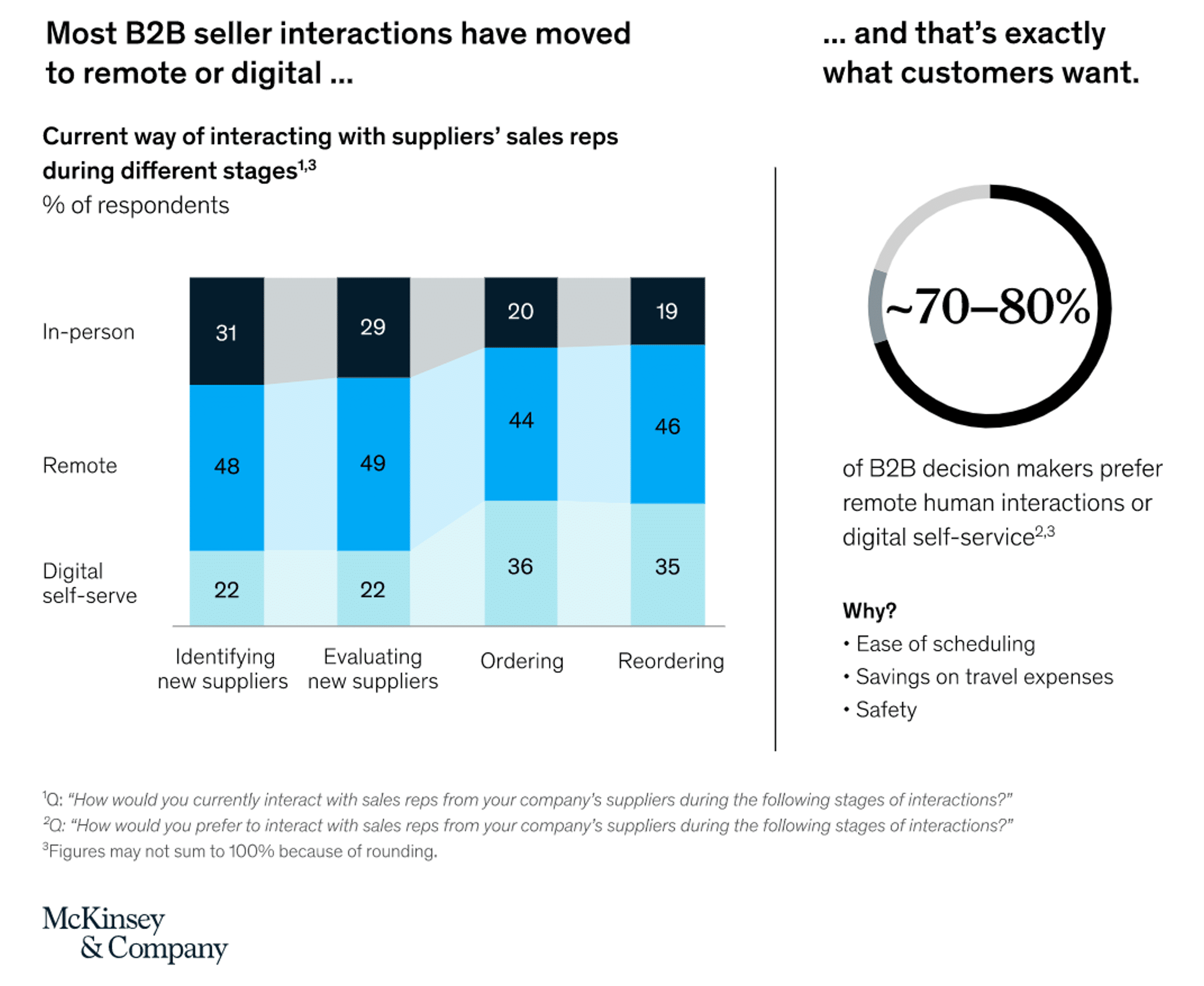
And according to Nine out of 10, B2B buyers say online content has a moderate to major effect on purchasing decisions. Also, Gartner has found that Information drives purchase ease and high-quality sales.
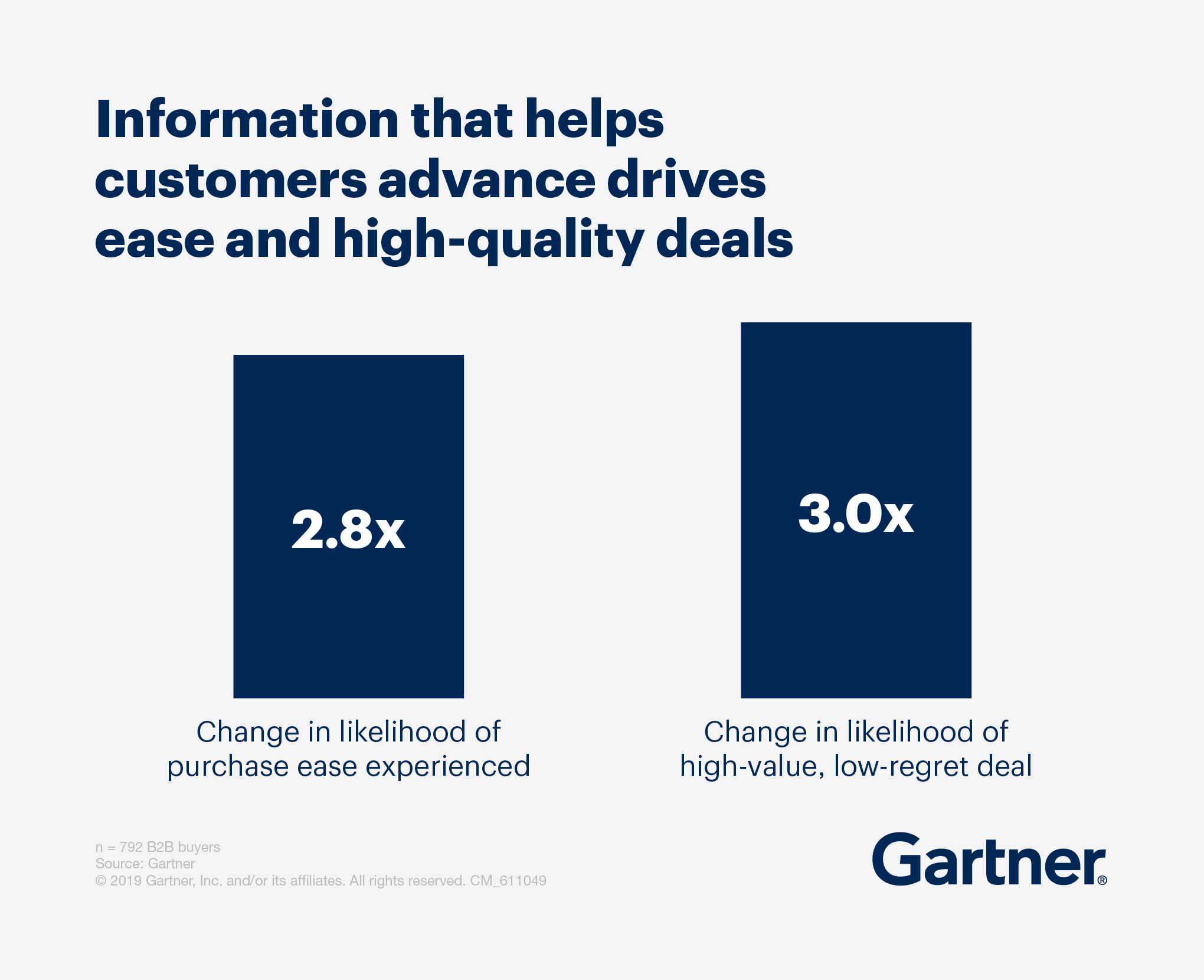
This could be due to the B2B buying process is becoming very complicated due to the vast amount of information buyers have access and anything that can help them to move in the buying process will drive purchase ease and confidence in the supplier.
And not only that but since the pandemic, B2B buyers are willing to make bigger remote purchases. More than two-thirds say they’d be prepared to spend over $50,000 on an entirely remote or self-service purchase.
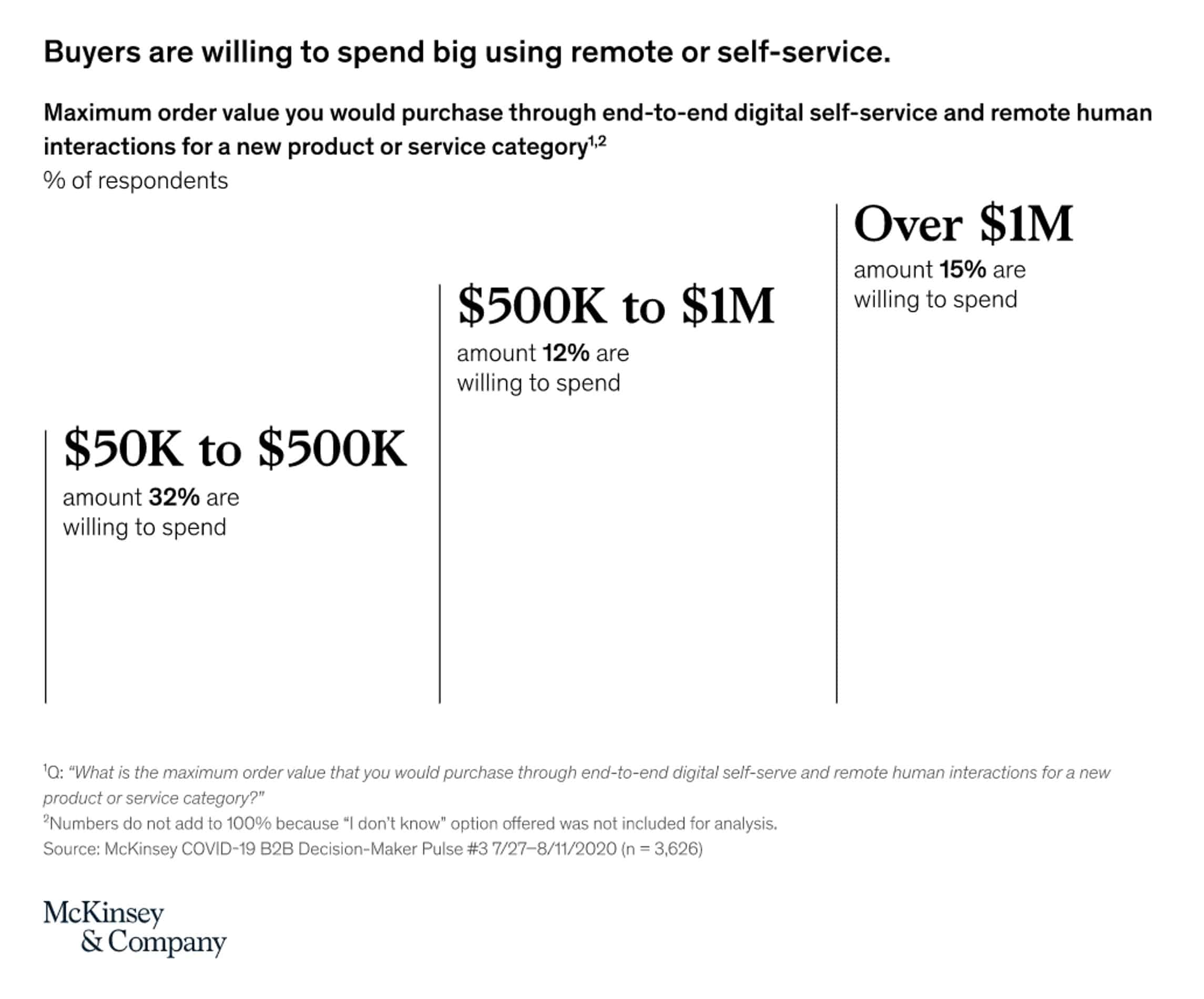
And there are many more statistics that prove B2B blogging is essential for b2b buyers to get the information they need and for companies to give them the information they are looking for.
However, what about the B2B blogging, how can it benefit your company and why should you use it? Here are 3 main reasons:
Reason #1: Organic Traffic is Cheaper than Paid Traffic
The first reason why you need B2B blogging is that it helps you to generate organic traffic and organic traffic is cheaper than PPC in the long run.
When it comes to PPC, you have to pay for every click you receive, it is instant and great to get your business off the ground right from the beginning.
However, unless you have a never-ending bag of cash, then PPC, should not be your main investment.
Let’s have a look at Microsoft website organic traffic example. According to SE Ranking, they are generating around 70-90M total monthly organic traffic, and the estimated cost for this traffic if they would pay for it using Google Ads is between the US $80-$130M every single month.
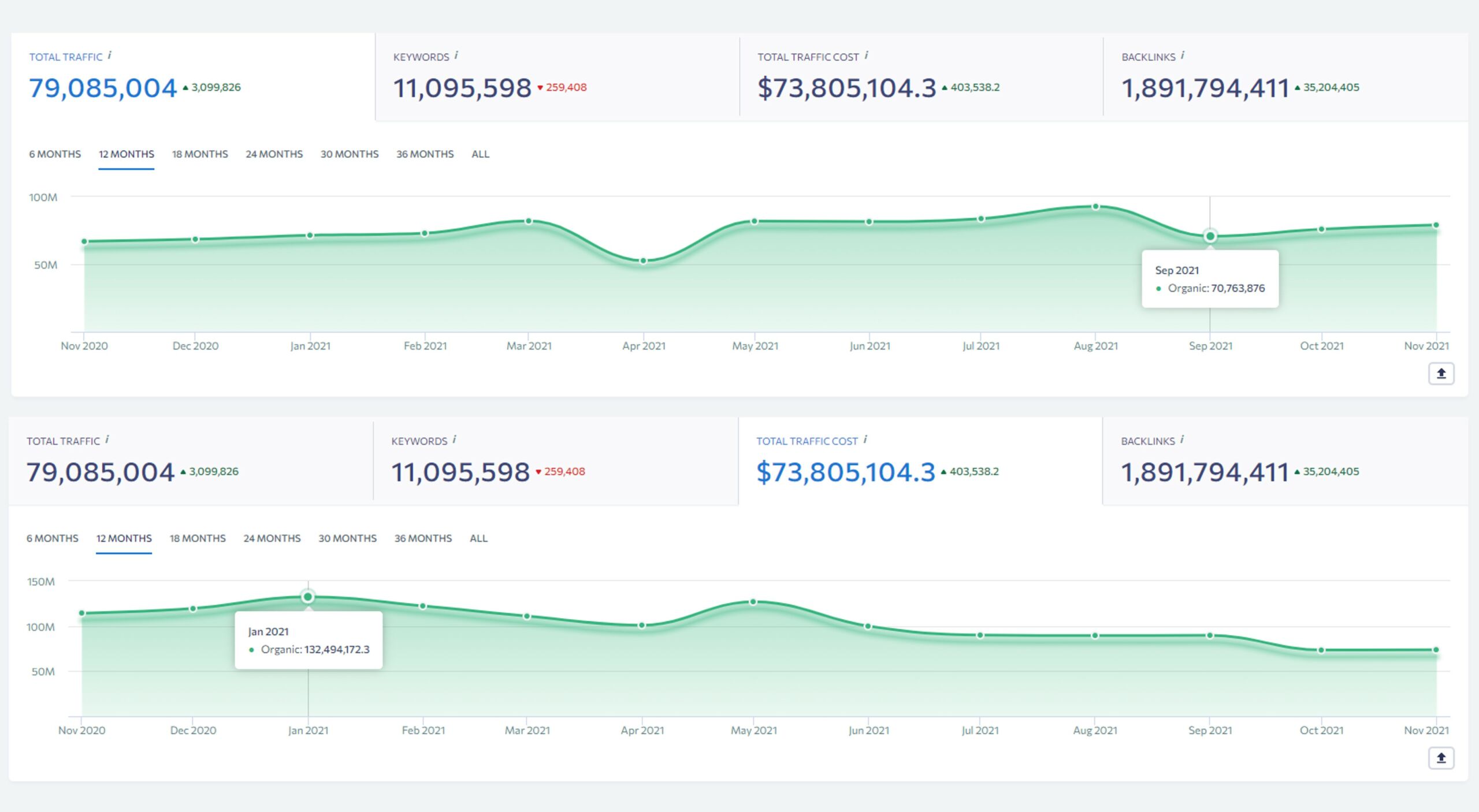
This is a lot of money even for Microsoft, even though they generate around 61 billion in net income.
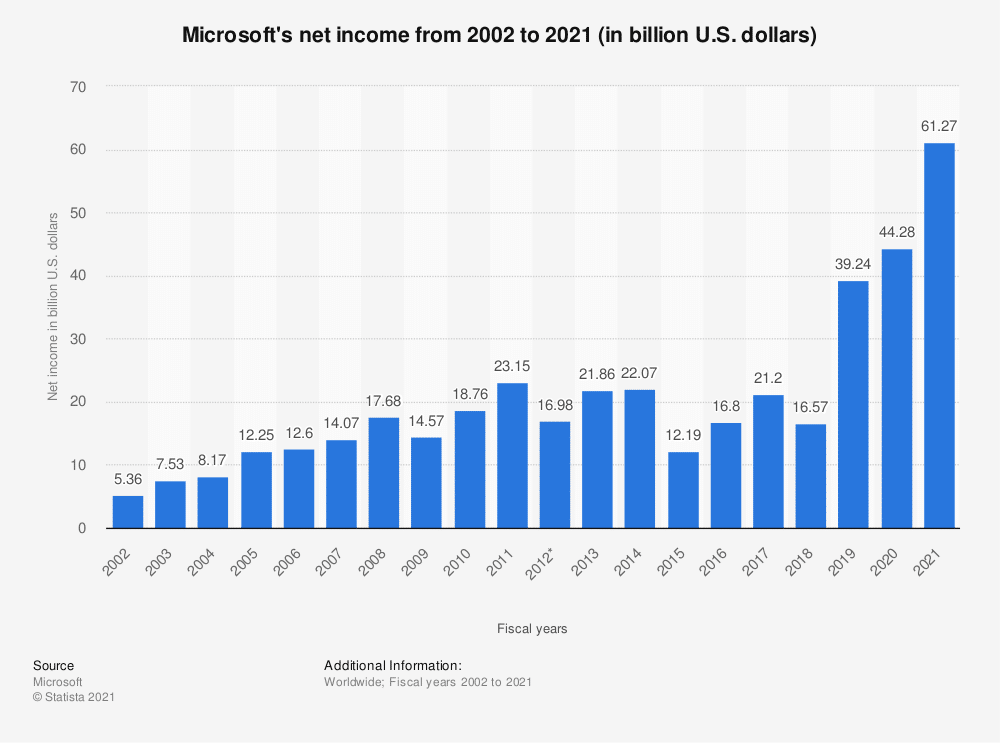
On the other side, B2B SEO is a great investment as it grows over time and the more you do it, the bigger returns you get. According to HubSpot, businesses that blog get 55% more website visitors than businesses that don’t.
However, it’s not for free. Nowadays you still need to pay for certain SEO aspects, whether it is for content creation, link building, or SEO tools. In fact, having a solid link building plan is crucial to ensure the success of your SEO efforts.
However, B2B Blogging is a very scalable and effective marketing strategy affordable even to the smallest companies, in fact, blogging is so scalable and affordable that it’s the third most common content marketing strategy for businesses.
Reason #2: Website Authority Will Increase
Another great reason why you should start with B2B blogging is that it increases your website authority and it brings ton of link building benefits.
Blog posts are great for attracting high-quality backlinks for your website, according to Demand Metric, blogs are responsible for 97% more indexed links.
And if you analyze the backlink profile of your competitors, there is a high chance that most of their high-quality backlinks are pointing to their blog posts.
For example, my competitor a marketing agency Single Grain with a DT of 87 has generated over 450k backlinks,
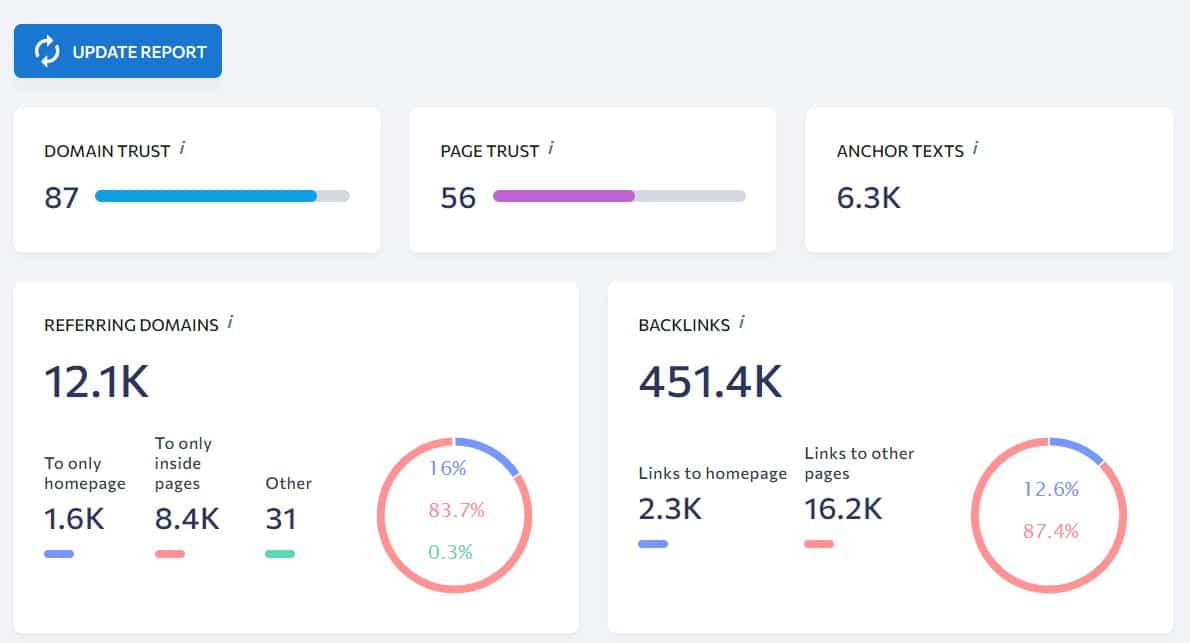
which most of their backlinks were generated by their blog posts.
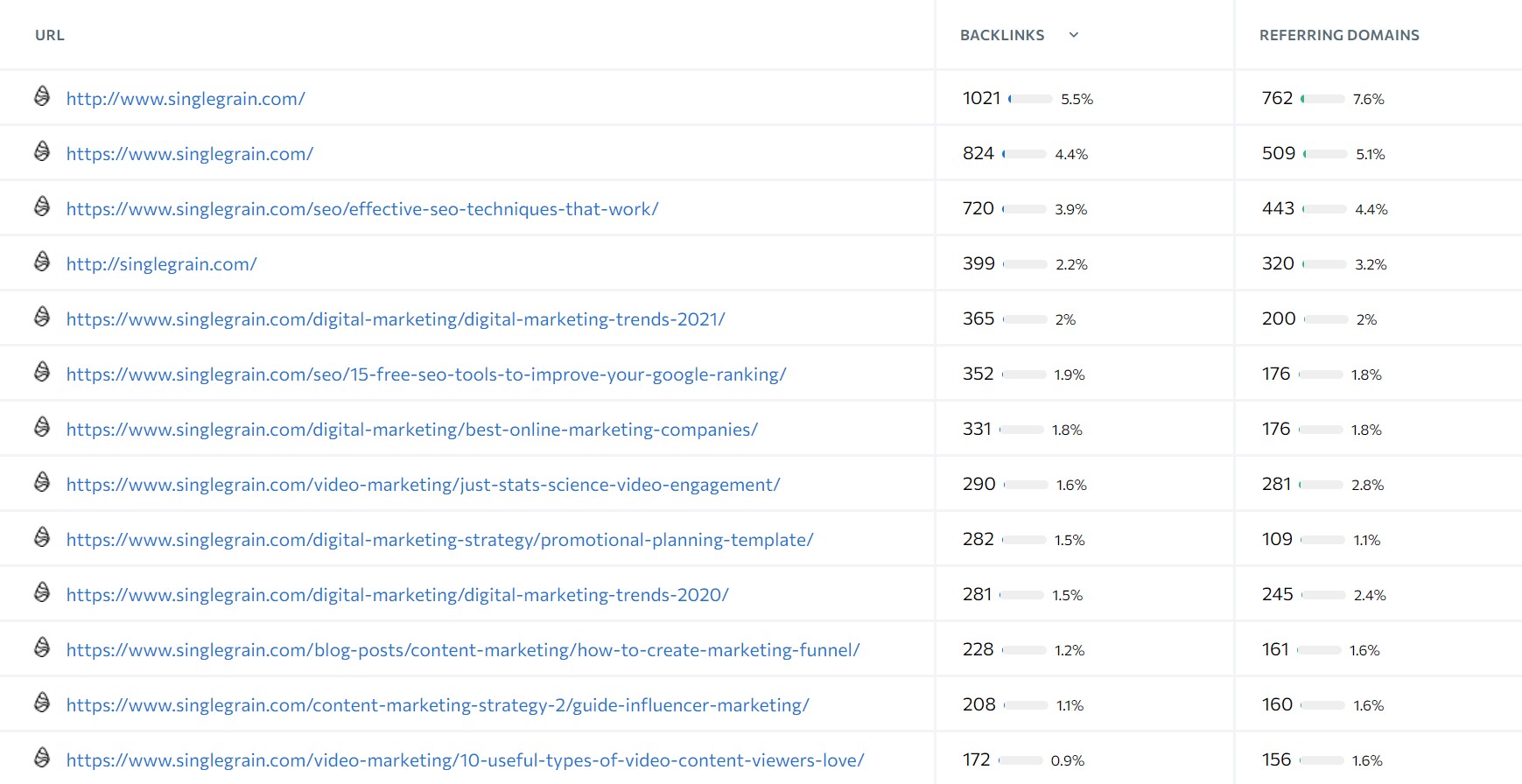
With that, once your blog posts start bringing backlinks, then it is easy to spread the Page Rank from those backlinks to your money pages such as product, service, or category pages to increase ranking for your profitable keywords. It’s also important to track any backlinks that you’ve built to ensure you can preserve them as long as possible.
Reason #3: Your Lead Generation & Quality and Quantity Improve
And the third reason why B2B blogging is essential for your business is that B2B blogging increases your SEO lead generation and improves the quality of leads.
According to Demand Metrics, Companies with blogs produce an average of 67% more leads monthly than companies that don’t blog and 81% of businesses report that their blog is important or critical in generating leads.
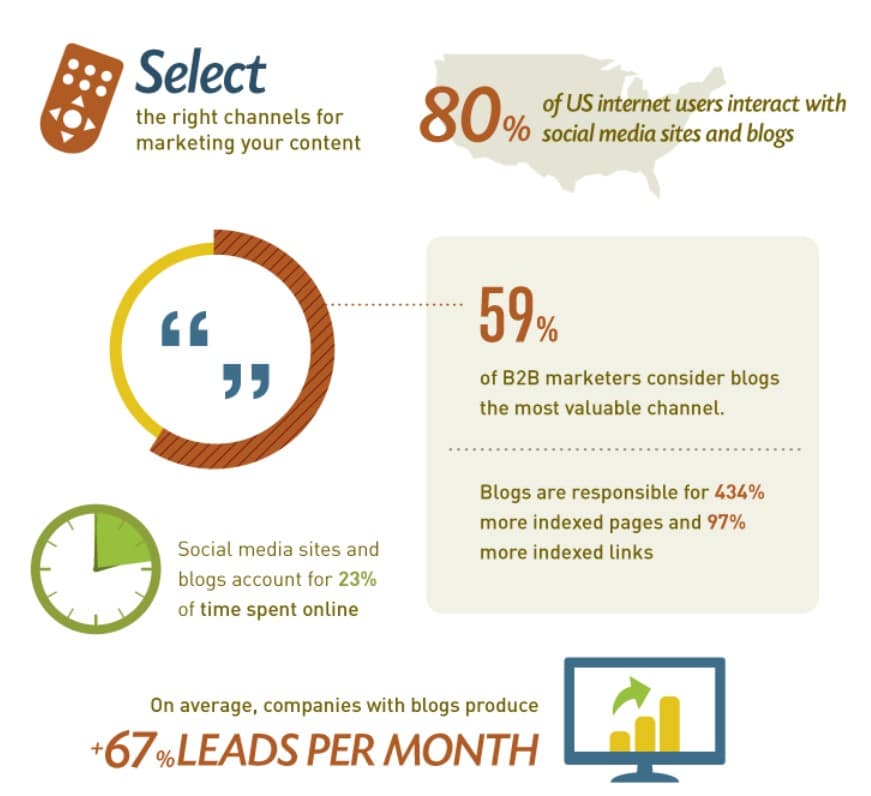
On top of that, because B2B blogging generates organic traffic, the lead quality improves as well. This is because, you have higher visibility in search, creating more touchpoints in the buyer journey and addressing more needs of your B2B target audience.
And according to Search Engine Journal, leads from SEO have a 14.6% conversion rate, while only 1.7% of paid leads convert.
From my experience, the average conversion rate for B2B leads to B2B opportunities from Organic sources is around 20-30% while the average conversion rate for B2B lead to B2B opportunities from Paid source is around 15-20%.
With all this, there are many more B2B blog benefits of why you should start with B2B blogging and include it within your SEO strategy. But let me share with you some of the B2B blogging best practices for your company to achieve the results I have mentioned and more.
However, its also important to note that B2b Blogging and Blogging for Business is not the same as B2B blogging is purely focuses on B2B target audience and B2B companies, while blogging for business is for any business that wants to achieve their strategic objective with blogging.
Best Practices for B2B Blogging
Practice #1: Generate Keywords Around Topic Clusters
The first practice I have for you is to generate keywords around your targeted topic clusters.
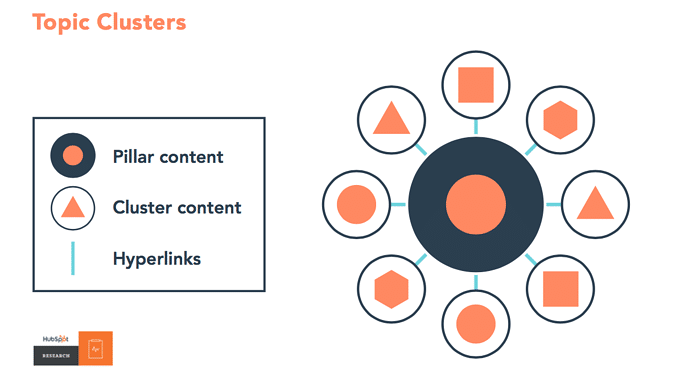
For example, if you are in the Whiskey niche, then one of the topic clusters you would want to target for example is the Irish Whiskey topic.
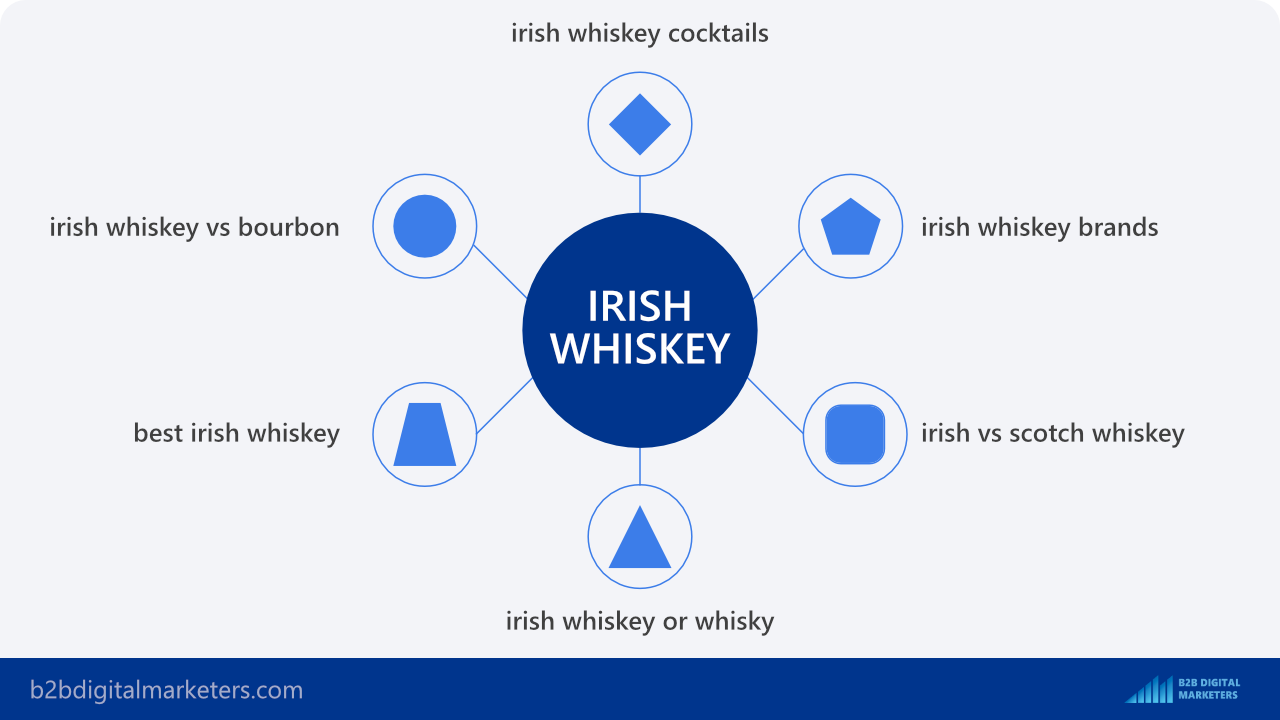
You simply want to target all the keywords related to the topic “Irish Whiskey” to create topical relevancy on your website and therefore own the topic in the search.
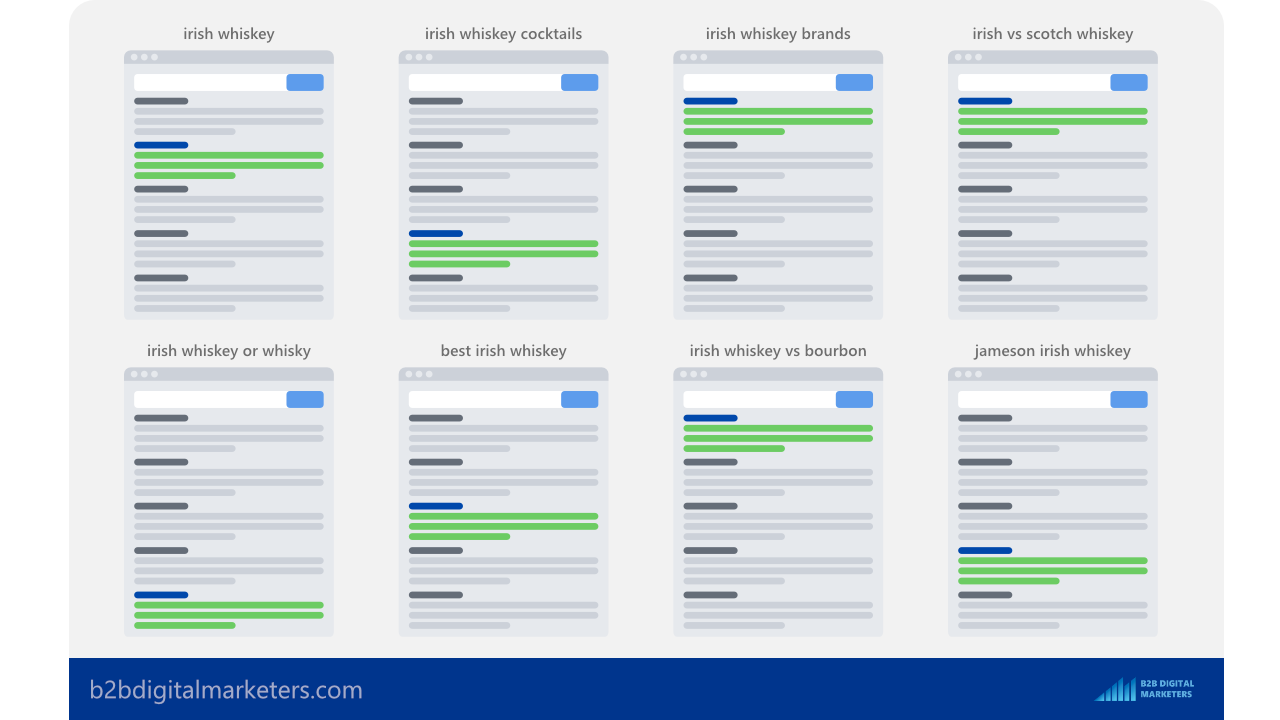
So, to create a topic cluster, you simply need to toss one of your main topics also called seed keywords in keyword research tools like SE Ranking. In this example it is the seed keyword/topic “irish whiskey” and I also selected my target location.
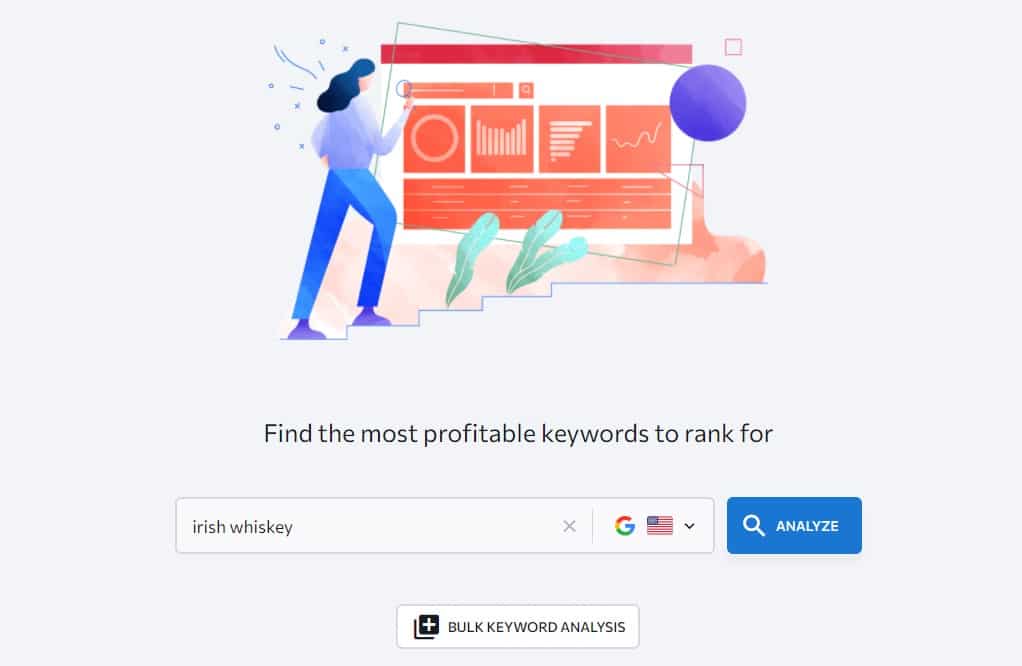
Then in the “Keyword Suggestion” report, I select all the keywords that are subtopics to my main keyword “irish whiskey” and can be targeted with individual blog posts.
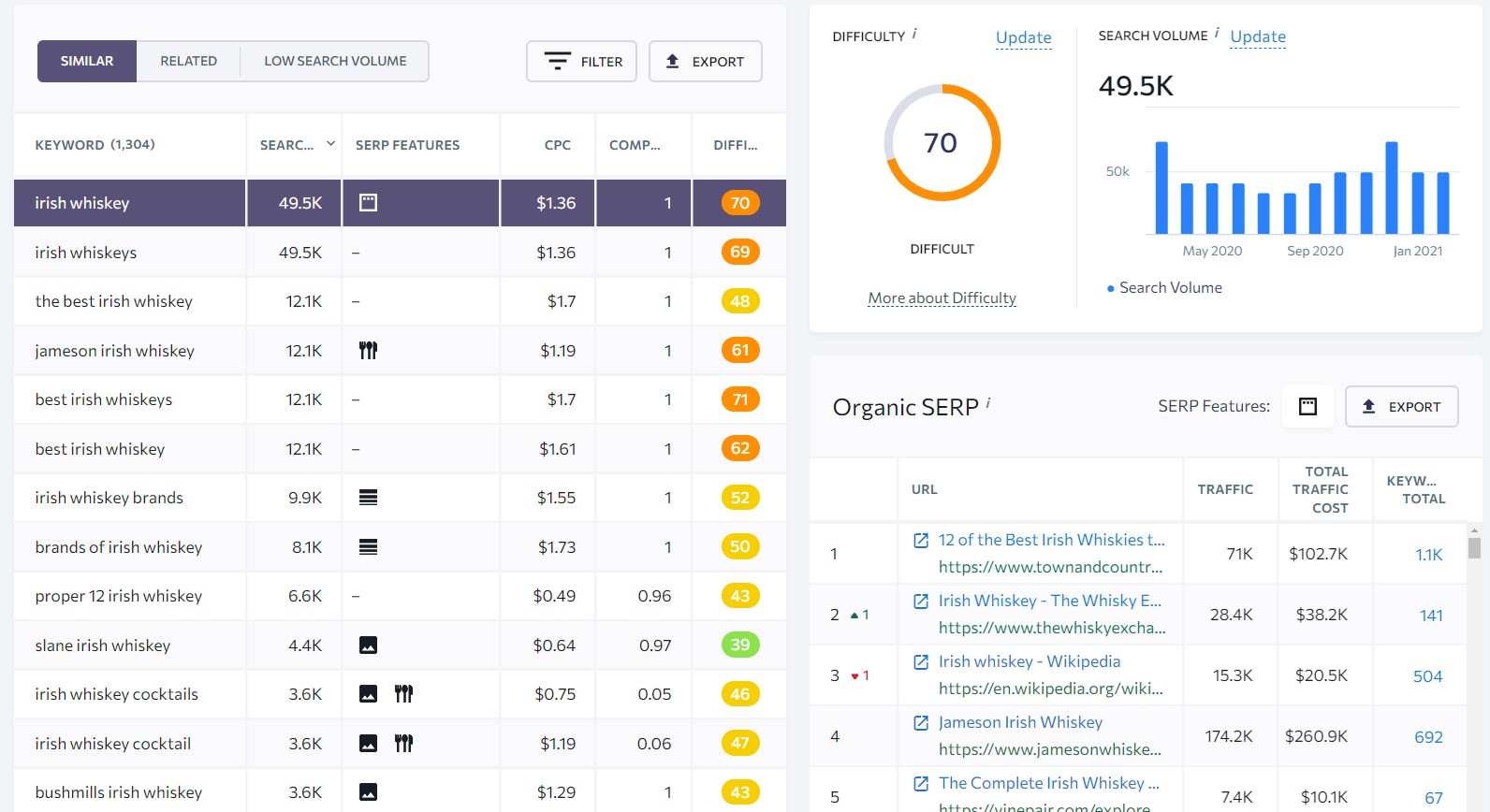
Make sure to check every keyword to ensure you don’t end up with keyword cannibalization.
For example, the keywords “best irish whiskey” and “good irish whiskey” have the same ranking pages.
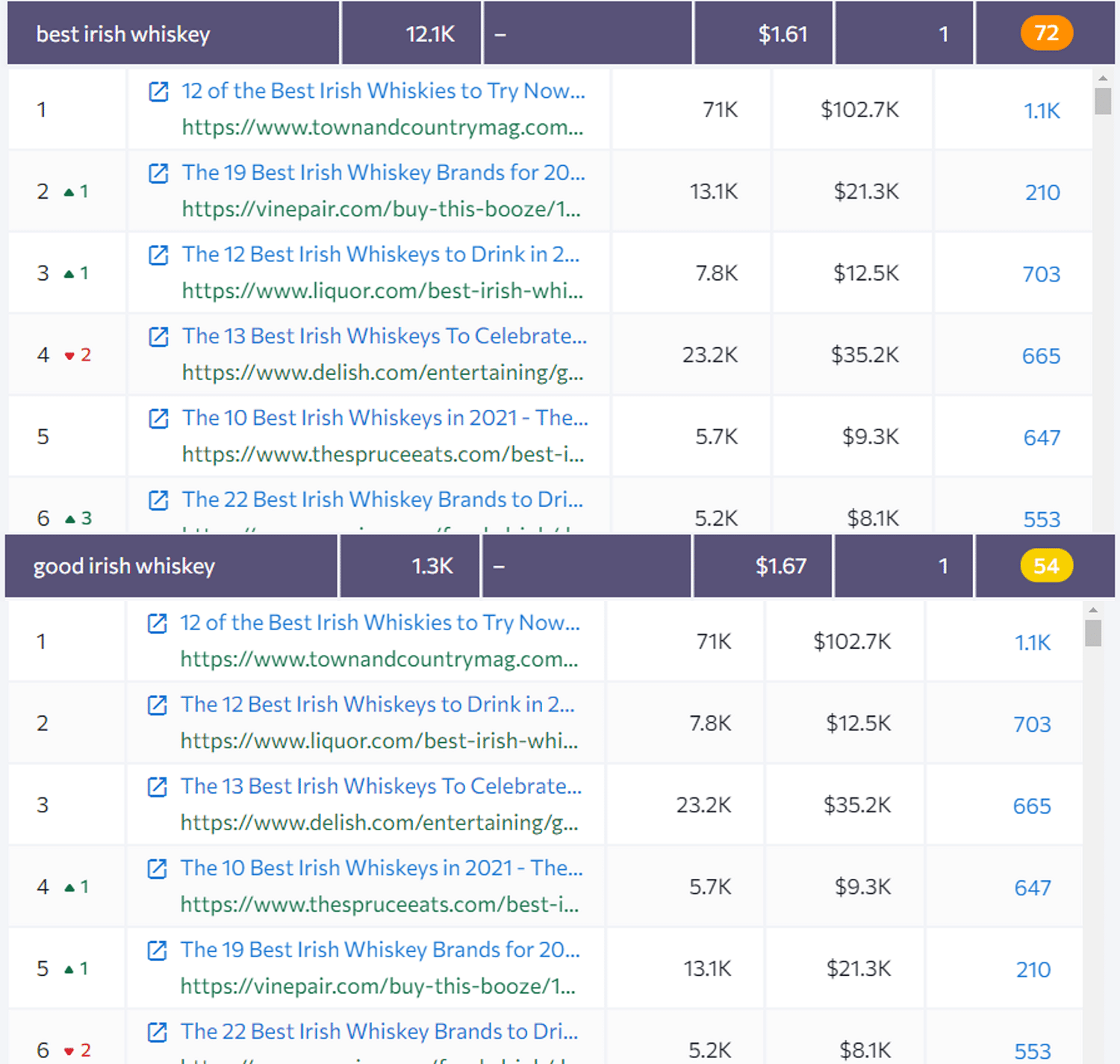
Thus, you should target only the keyword “best irish whiskey” and add the keyword “good irish whiskey” as an LSI keyword in the content to rank for both of these keywords and maximize your SEO potential and avoid one of the biggest B2B blogging mistake marketers make.
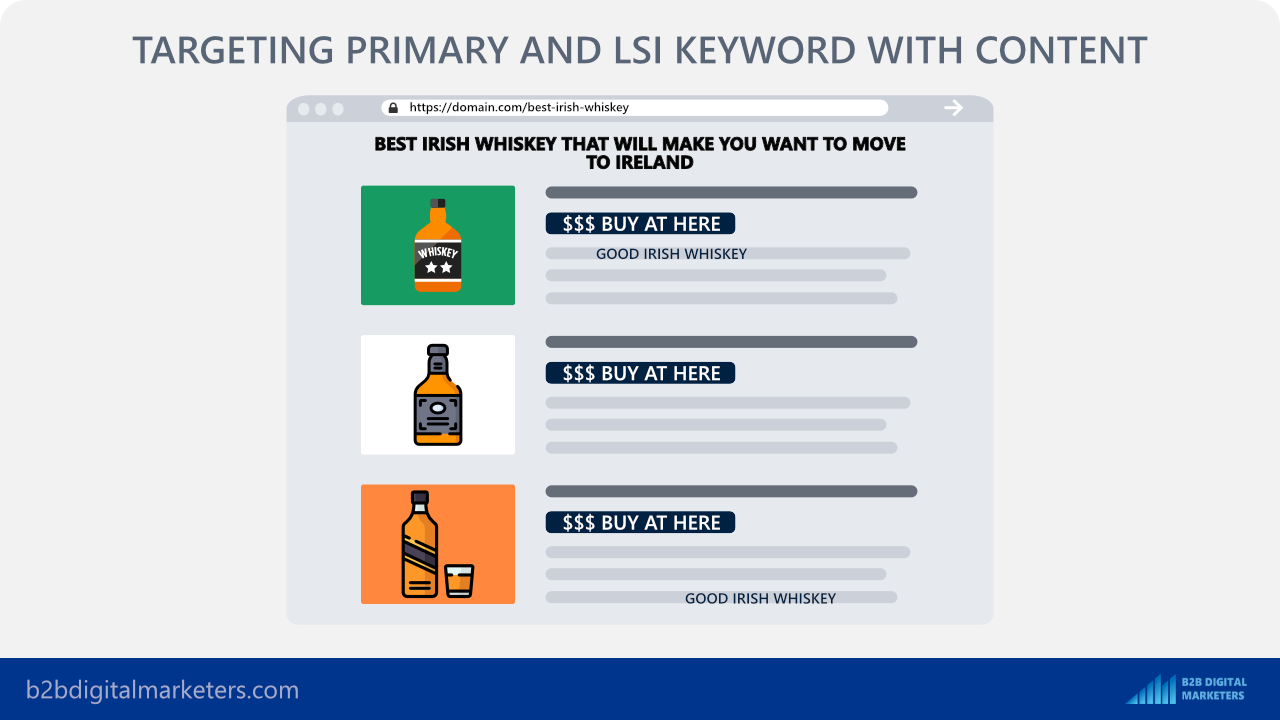
And just like this, you can find SEO keywords for your main targeted topic clusters.
Practice #2: Go Deeper with Semantic SEO
The second very important practice you should follow with your B2B blogging is to focus on Semantic SEO.
Search engines always struggled with understanding the content on the internet and Semantic SEO helps search engines to properly understand the content on your website and how your content is related to each other so search engines can better rank your content in terms of relevancy.
And going deeper with Semantic SEO means you should not only focus on the keywords in your topic cluster but on relevant “entities” or topics and subtopics in your niche that you want to rank for.
The goal with Semantic SEO is to help crawlers to understand your content by using terms, entities, and facts that are related to each other.
For example, if I want to write the article about SEO, then I would mention all the terms, entities, and facts like “keyword research”, “on-page seo”, “off-page seo”, “ranking factors”, etc. within the article to help search engines understand your content.
And then I would go deeper in the rabbit hole and write about “on-page seo” and again mention important entities like, “title tags”, “meta description” “keyword density” etc.
And after that, I would write the article about “Meta Description” and so on.
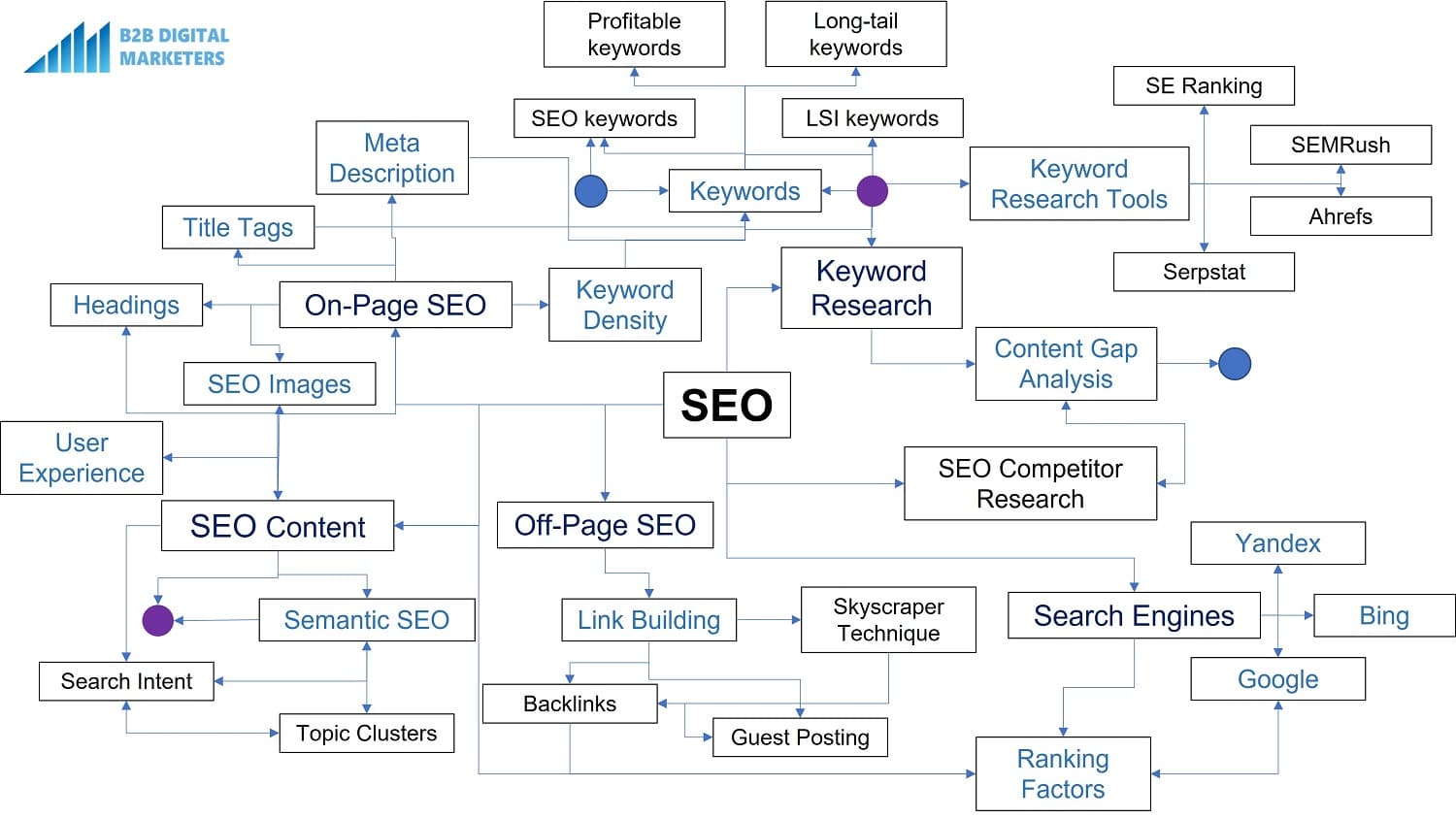
And this is how you should think about your keyword targeting and content creation. What you want to do, is to go in-depth with your content and address as many entities, facts, and terms within your niche as you can.
As that’s what Google is looking for, they want a source that provides all the information within the niche.
Therefore, you should optimize your keyword targeting around your niche-related terms to meet your user’s needs.
Be very strategic with your keyword targeting and then interconnect all those terms, facts, and entities together with internal or external links.
Just like I did in these paragraphs. I connected the entities I have mentioned here with my articles or relevant outside resources.
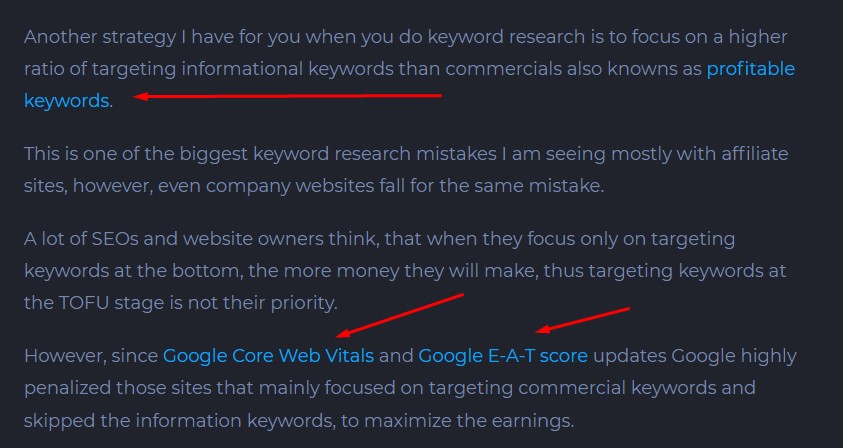
Practice #3: Search for Profitable Keywords
The third very important practice I have for you is to search for profitable keywords and one of the best B2B SEO practices.
The truth is that B2B blogging is not only about generating organic traffic for your website, but also about generating leads or sales for your business.
In fact, B2B blogging can be a great way to boost your revenue by directing your potential prospects to your product or service pages.
For example, why do you think companies that are developing sales management software are targeting B2B SEO keywords like “best sales management tools”?
It is because if they rank in the top positions they have direct power over the content and they can promote their own tool. For example, nutshell.com is recommending their tool as a first tool.
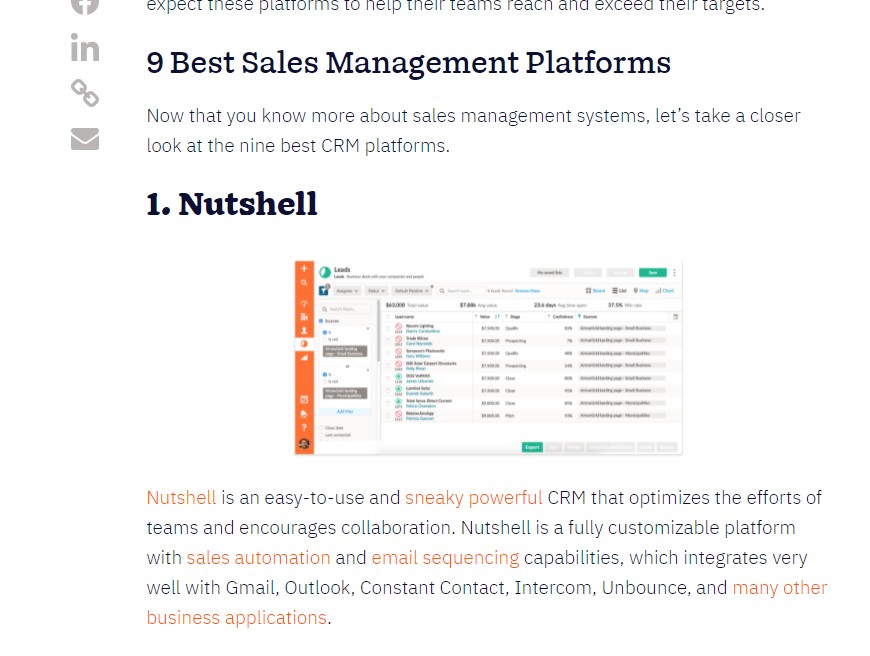
This means around 90% of people that visited this page saw the first recommended tool and according to SE Ranking, the page is generating around 1,200 organic traffic, which is usually underestimated number.

And you can easily calculate how many leads this one blog post can approximately generate:
- Around 90% of people saw the first tool, which is 1,080 from 1,200
- And if take a modest conversion rate of 10% from 1,080 people, we have around 108 leads every single month from this blog post alone.
Profitable keywords like this have a very high conversion rate as the search intent is very clear, but this can depend on the industry.
So, as you can see, targeting profitable keywords is very important, but don’t only target profitable keywords as Google would not rank you.
Practice #4: Analyze Competitors Ranking Keywords
Another very important practice I want to mention for your B2B blogging is to analyze competitors’ ranking keywords.
Analyzing competitors ranking keywords AKA content gap analysis is a technique where you find a close competitor that is doing well with their SEO and then sees the keywords, they are ranking for but you don’t.
Let me show you how it works:
Step #1: Find Your Close Competitor
To do that you can use SE Ranking Competitive Research Tool. Just pop your domain there, select your targeted location and click on analyze.
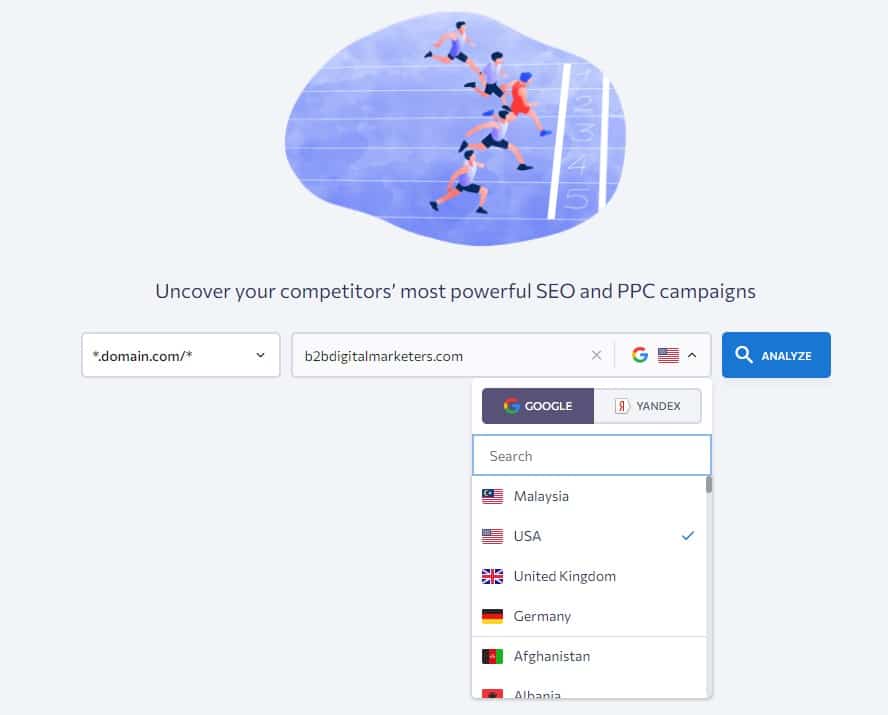
Then I’ll go to the “Competitors” report where I will get hundreds of close competitors based on my ranking keywords.
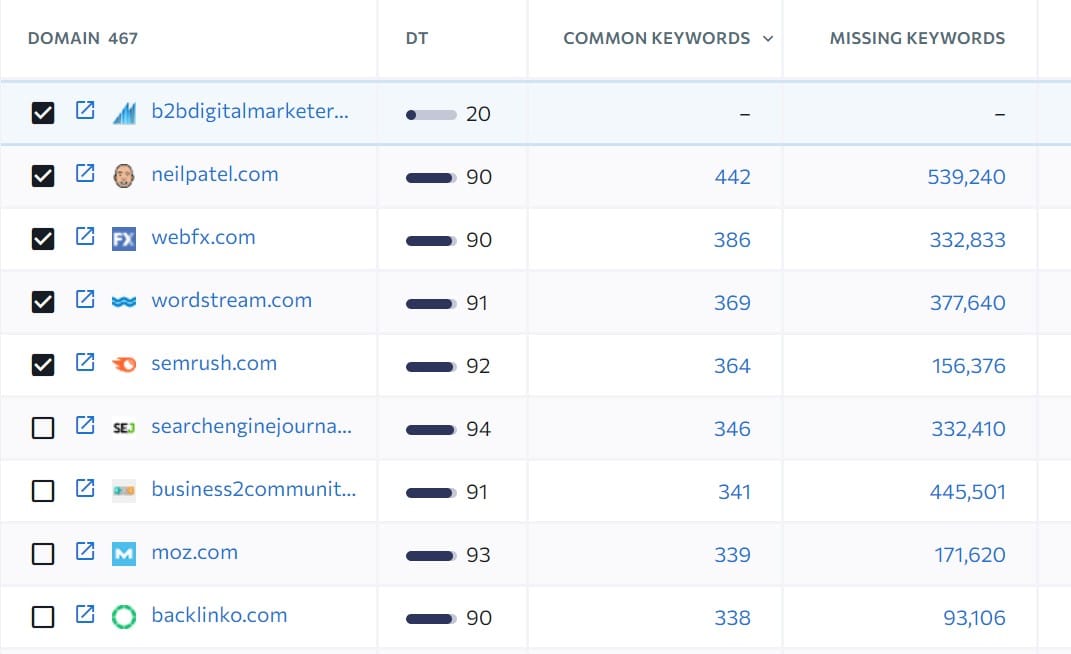
Step #2: Select the Right Competitor
Not every competitor displayed in this report is the right one for keyword gap analysis.
For example, the competitor webfx.com is not a good competitor for me despite they are ranking for over 15k “seo” keywords.
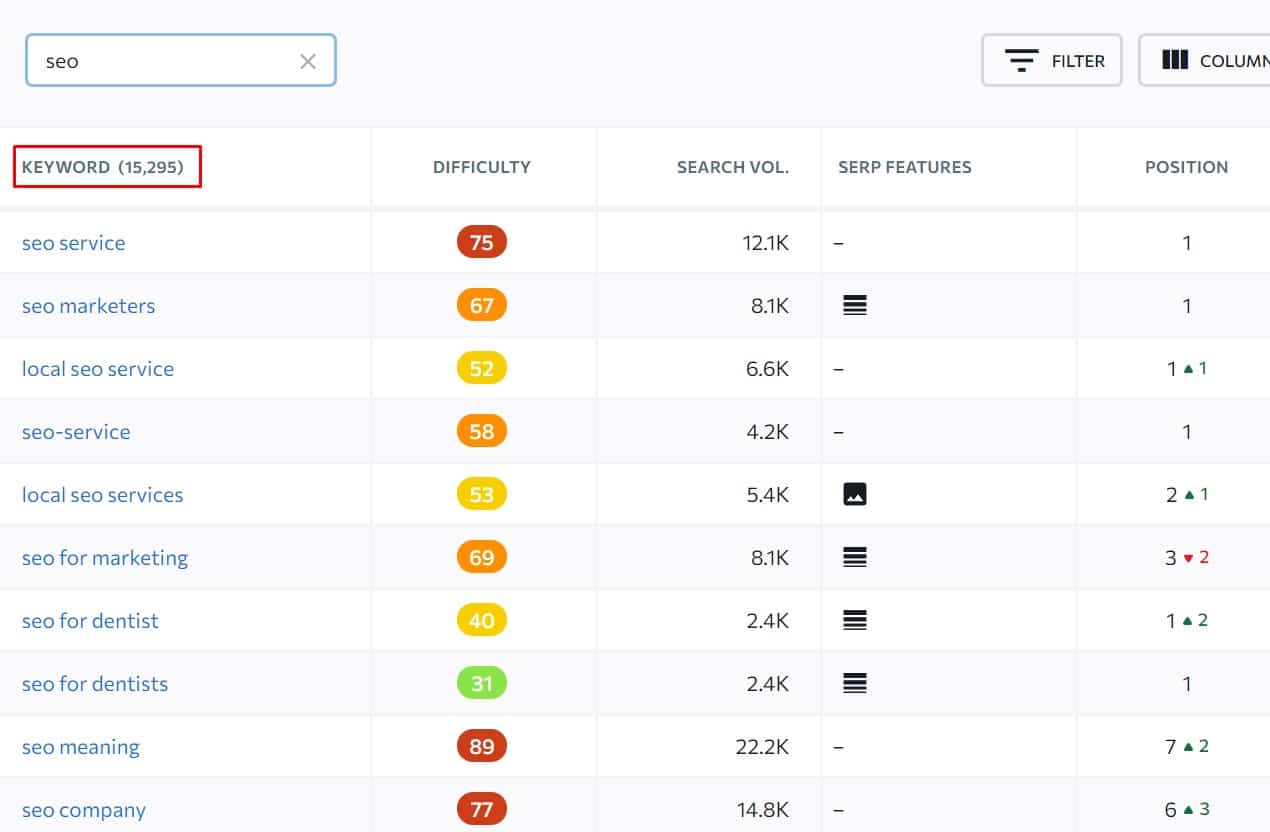
Because their targeting in marketing is so broad that it would be really difficult for me to find interesting keywords.
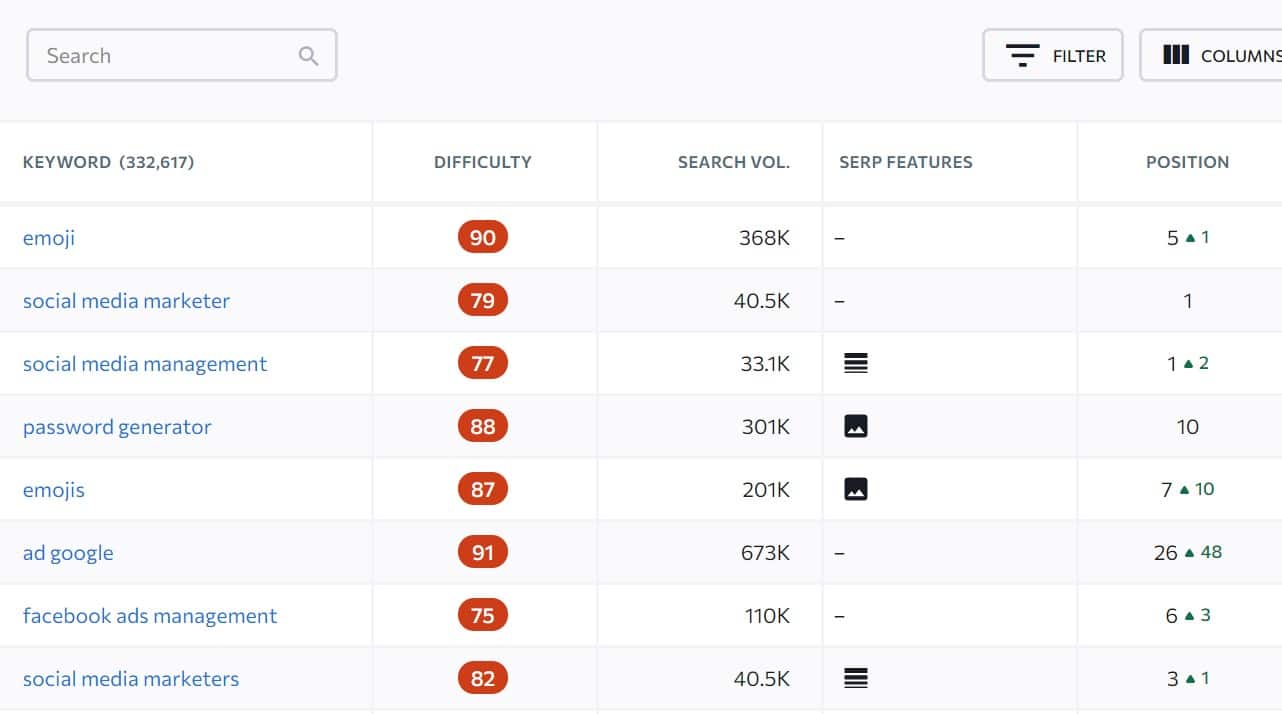
But a competitor like Backlinko.com is a perfect competitor as Brian is mainly targeting keywords in the SEO niche with a bit of Content Marketing, just like me and just like me he started alone and slowly build a team.
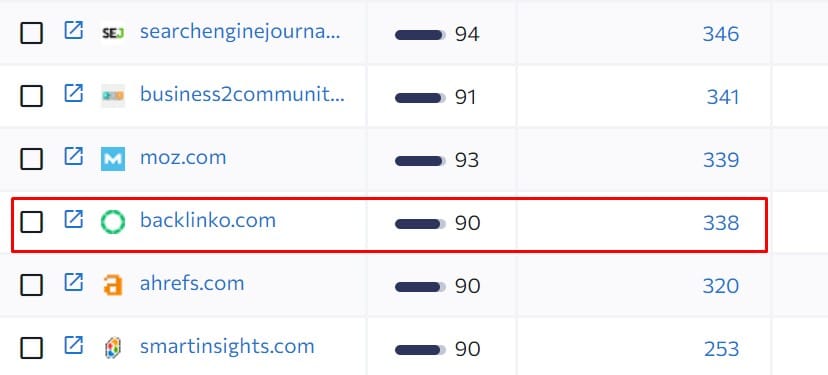
Step #3: Analyze Your Competitor
And once you have your competitor then you just need to compare your ranking keywords with your competitor using SE Ranking Competitor Comparison.
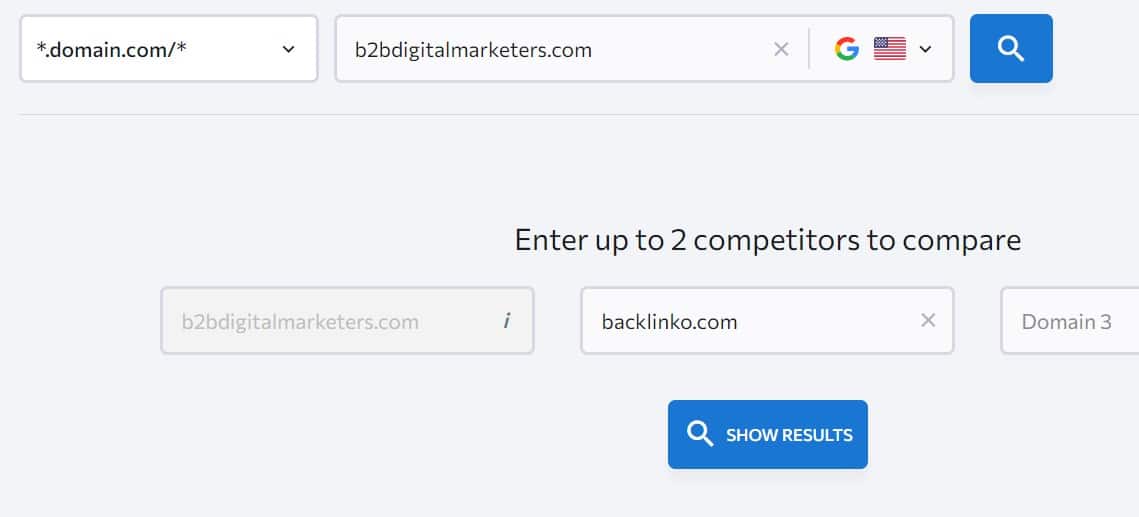
And then check out the “Missing” and “Unique” keywords tabs to find high-quality keywords that your competitor is targeting but you don’t but you should be targeting.
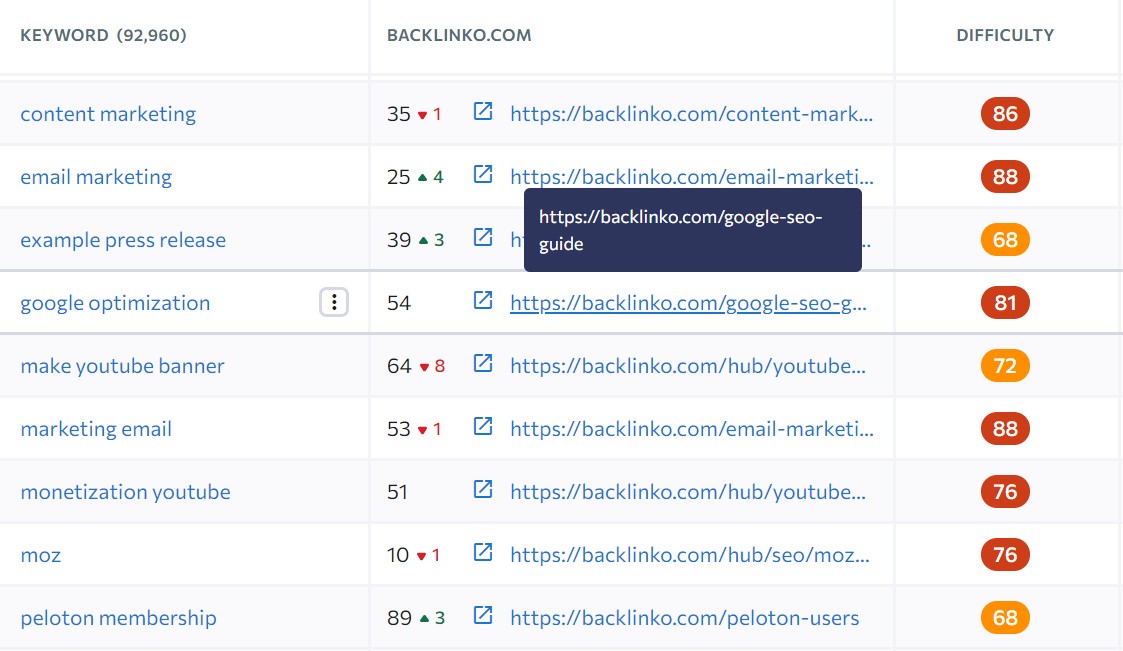
And there you have it.
Practice #5: Analyze Keyword Search Intent
The next important practice is to analyze search intent for your targeted keywords.
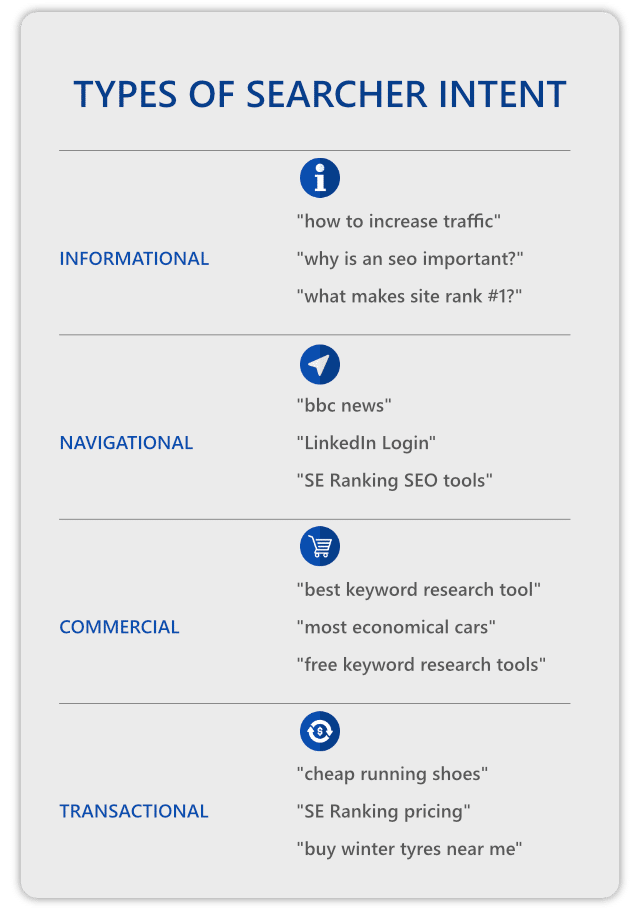
Search intent means the reason behind the searcher’s query and what content they expect and want to see. It gives you the essential information on what content you should create to target the keyword as well as if the keyword is a primary or LSI keyword.
Also, search intent helps you to target keywords across all stages of the buyer journey to maximize your SEO potential from B2B blogging.
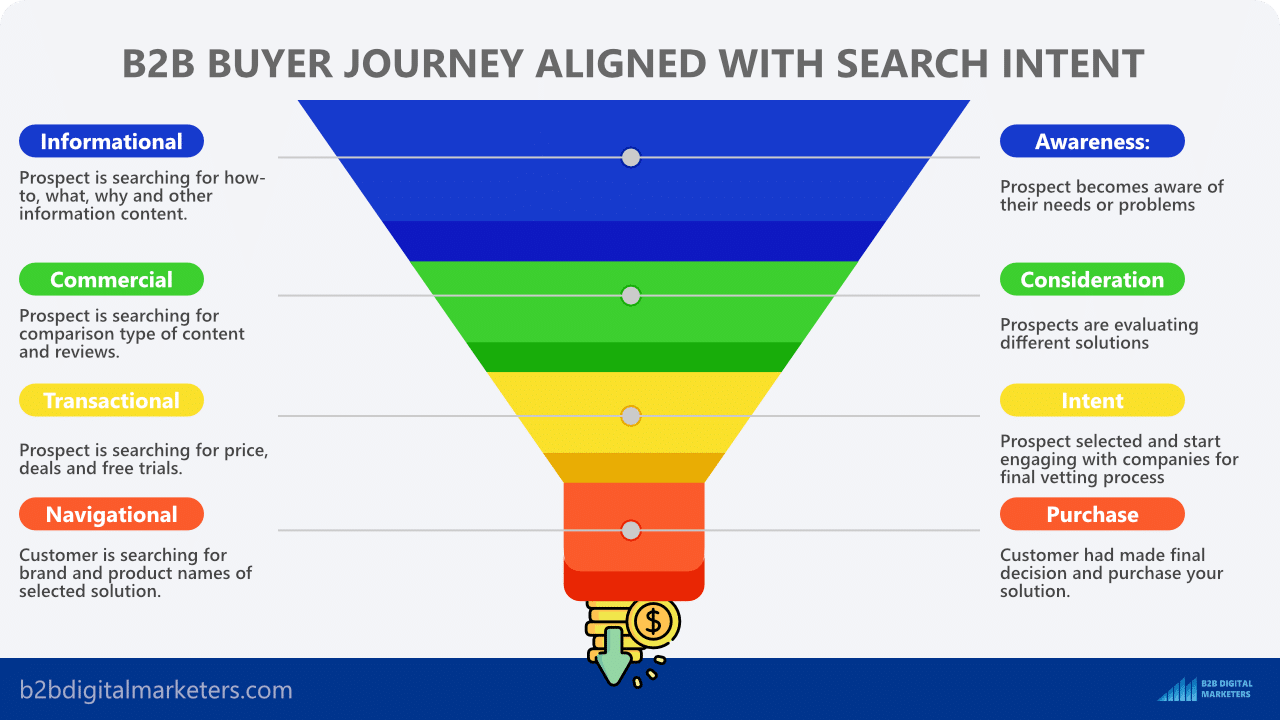
So, to find the search intent you just need to analyze the Google SERPs for your targeted keyword. I recommend you use keyword research tools to get the exact search results for your targeted location.
First, put the keyword that you want to target in the keyword research tool, I’ll use SE Ranking, and let’s use the keyword “seo strategies” as an example to analyze search intent.
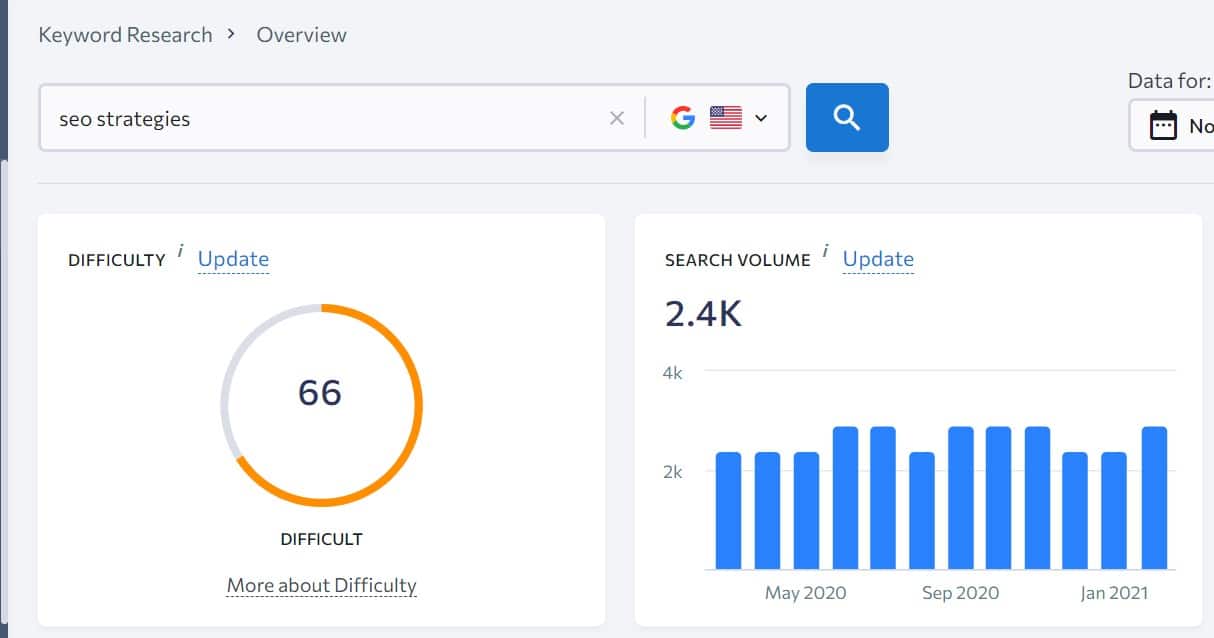
Then I go to the “Organic Results” report to see the top-ranking pages. Now, this keyword is clearly informational type, as all the pages are blog posts.
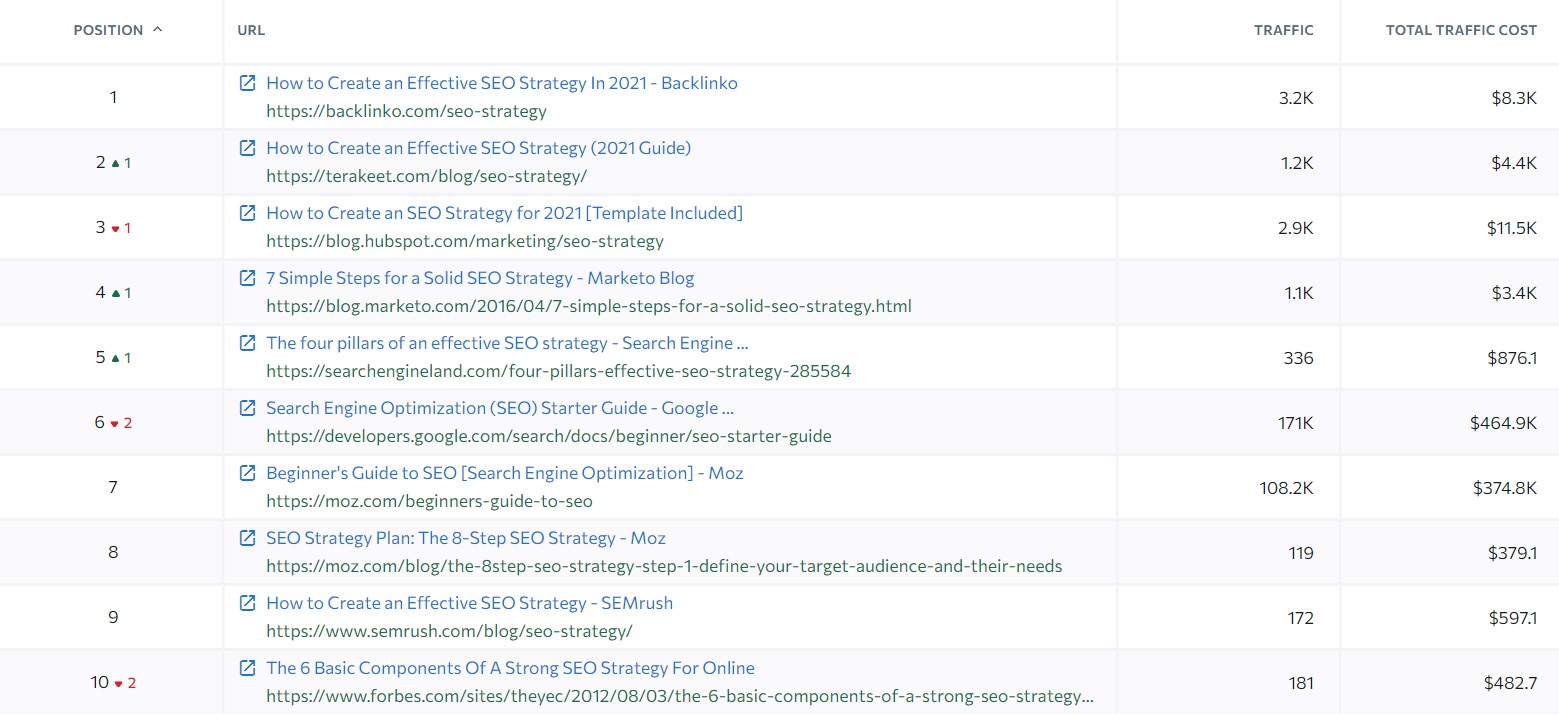
However according to the ranking pages, I can see that the keyword “seo strategies” is not a primary keyword, but more like an additional keyword to another primary keyword.
The first primary keyword is “seo strategy” as I can see in the top-ranking pages.
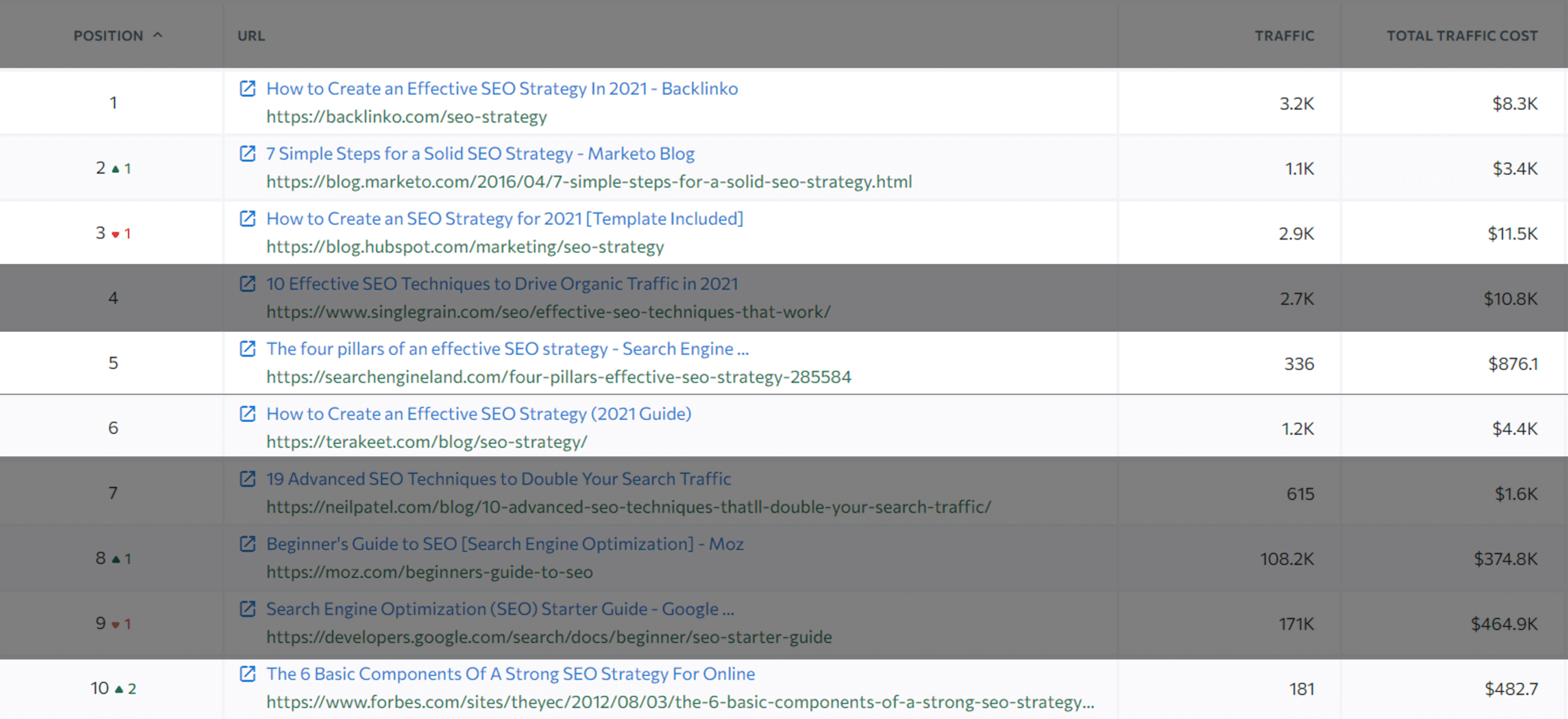
And the second primary keyword is “seo techniques”.
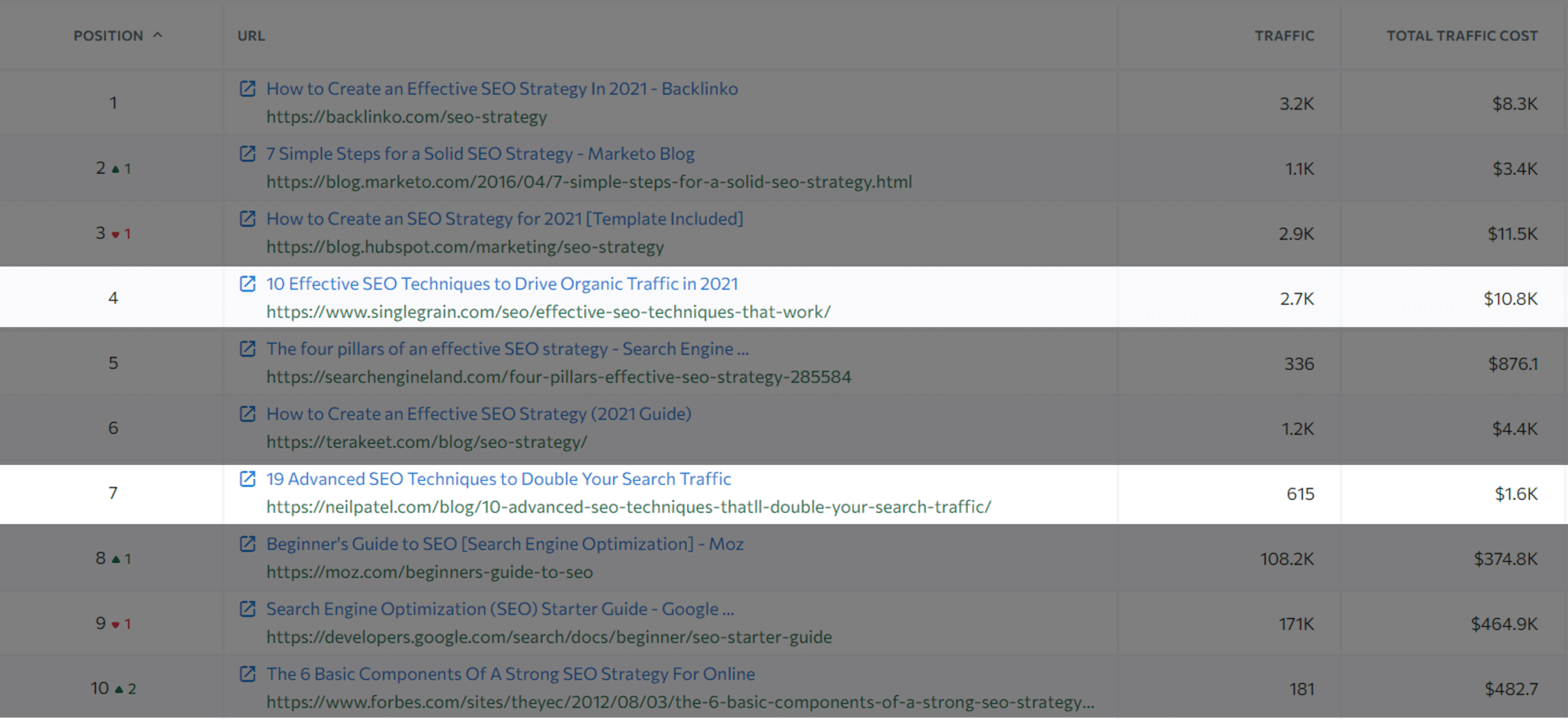
So, the keyword “seo strategies” is not a primary keyword and has mixed search intent and for me to rank for this keyword I need to target the keywords “seo techniques” and “seo strategy”.
Therefore, let’s analyze the keyword search intent for “seo strategy”.
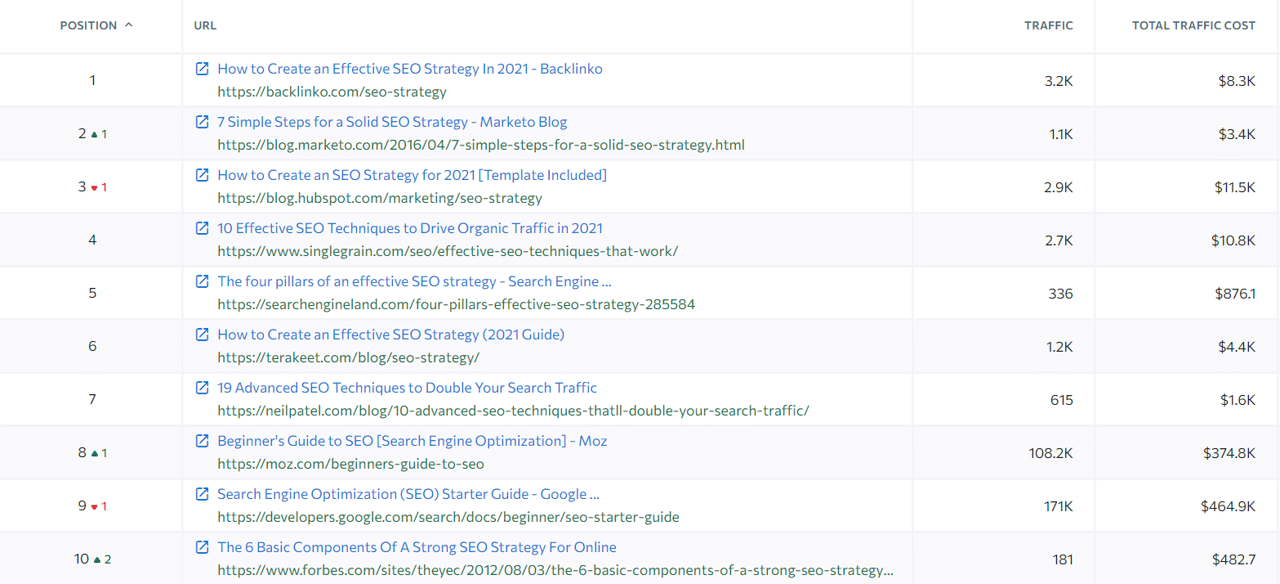
So, this is an information type of keyword as well, as I need to create a step-by-step tutorial on “how to create SEO strategy” to rank for this keyword.
As you can see, determining search intent is not as difficult, as you just need to follow Google search results.
Also, you can use my table of keyword modifiers that indicates the search intent, but please take it with pinch of salt.
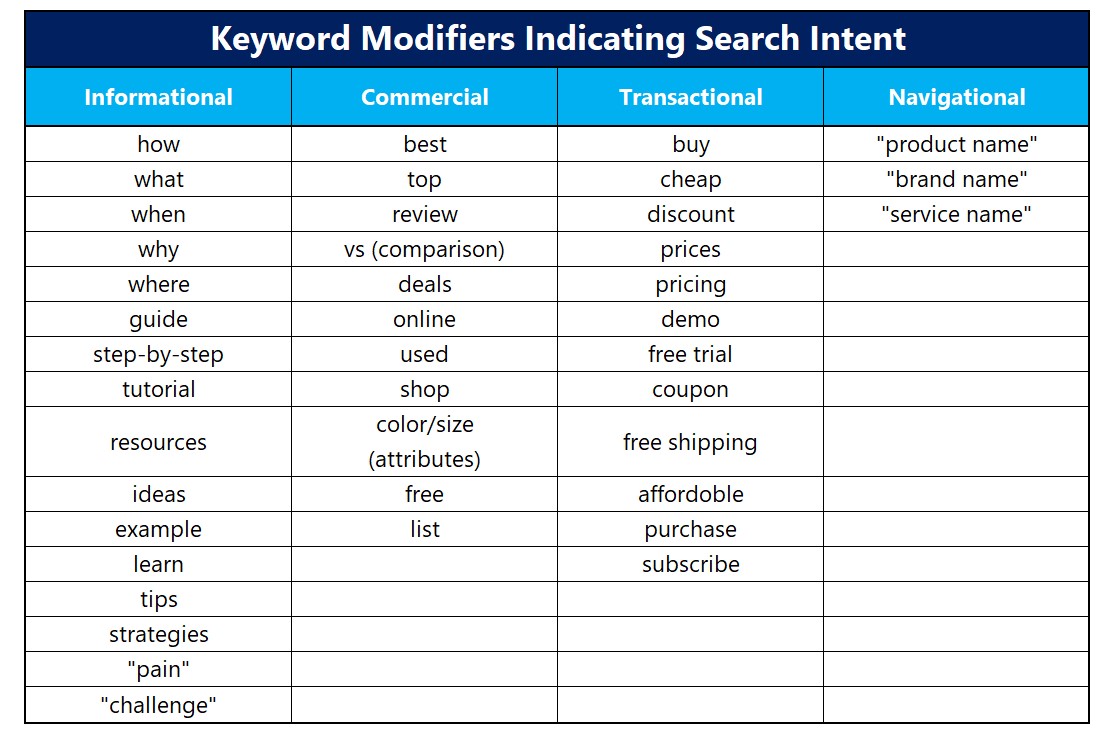
Practice #6: Target Low Difficulty Keywords First
The sixth important practice I recommend you to follow is to target low-difficulty keywords first when you are starting out.
And the reason is obvious as you have a much bigger chance to rank for those keywords in top positions compare to competitive keywords.
As a rule of thumb, the easy to rank keywords are long-tail keywords, compared to the body or head keywords.
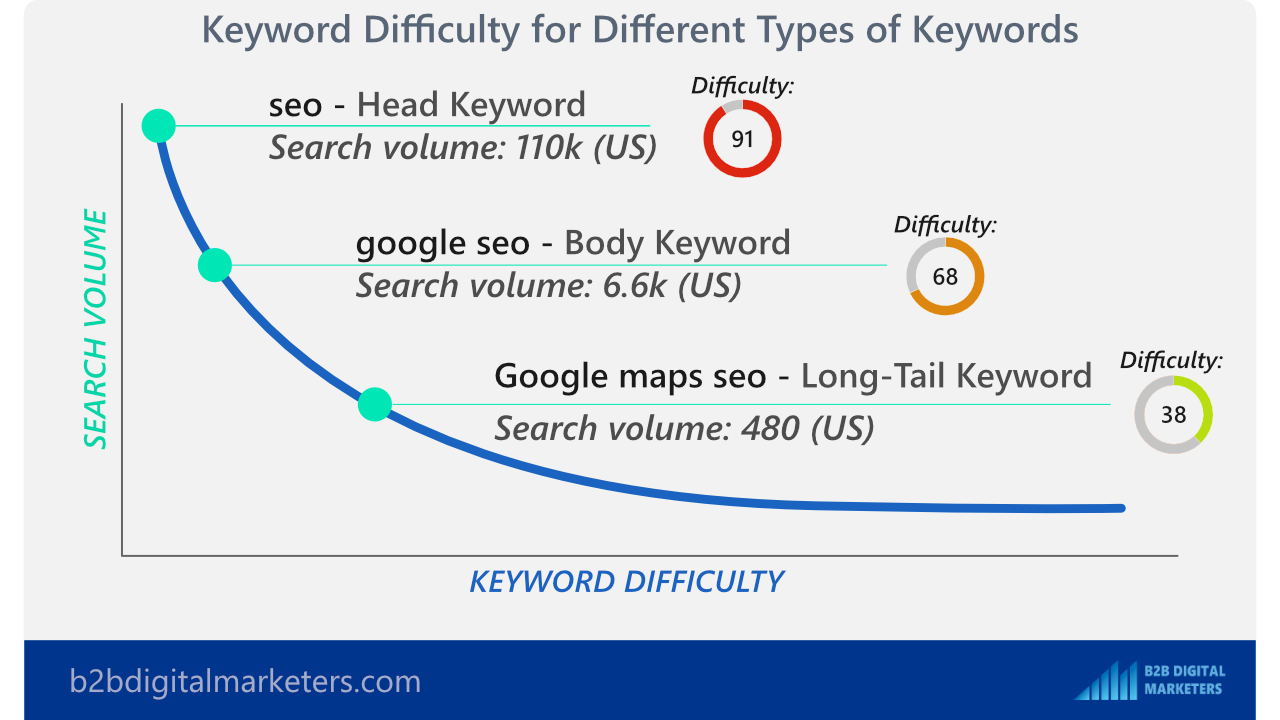
However, it’s better to always use an SEO tool to better understand the keyword difficulty.
For example, you are in the gardening niche, and you found a bunch of keywords related to your niche.
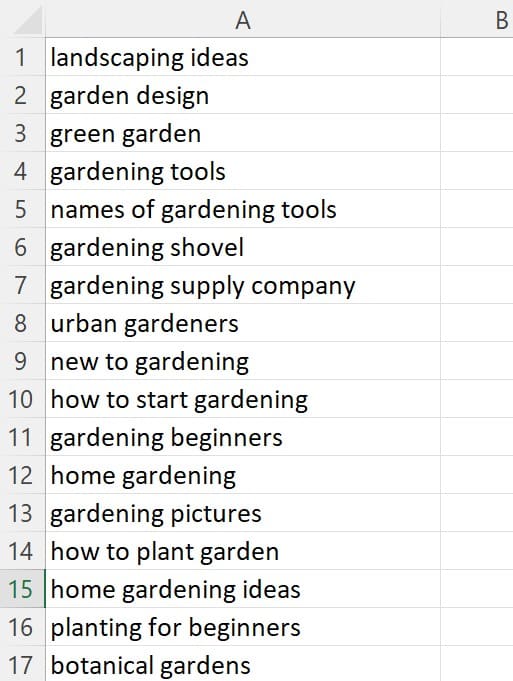
So, you can pop these keywords in Keyword Bulk Analysis like SE Ranking and you will get the keyword difficulty for all of your keywords as well as with additional helpful information.
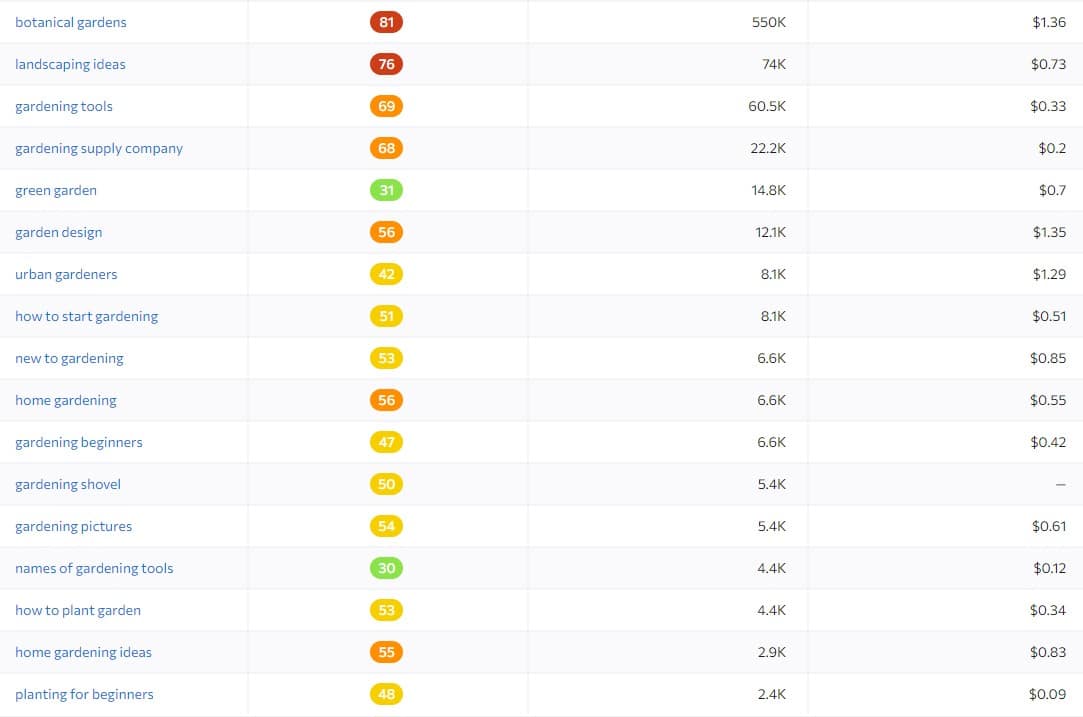
And like this, you can start targeting those keywords with the lowest keyword difficulty to start driving organic traffic with small website authority.
Of course, you still want to follow your topic cluster model and target your keywords there first and not just jump from keyword to keyword across different clusters.
Practice #7: Add LSI Keywords
Another very important practice you should think of is to add LSI keywords to your articles and this has a lot to do with Semantic SEO.
Many marketers have the opinion that LSI keywords do not exist including John Mueller, the search advocated for Google, who stated:

However, the publication: “Improving topic clustering on search queries with word co-occurrence and bipartite graph co-clustering” says that Google does use words that frequently occur together.
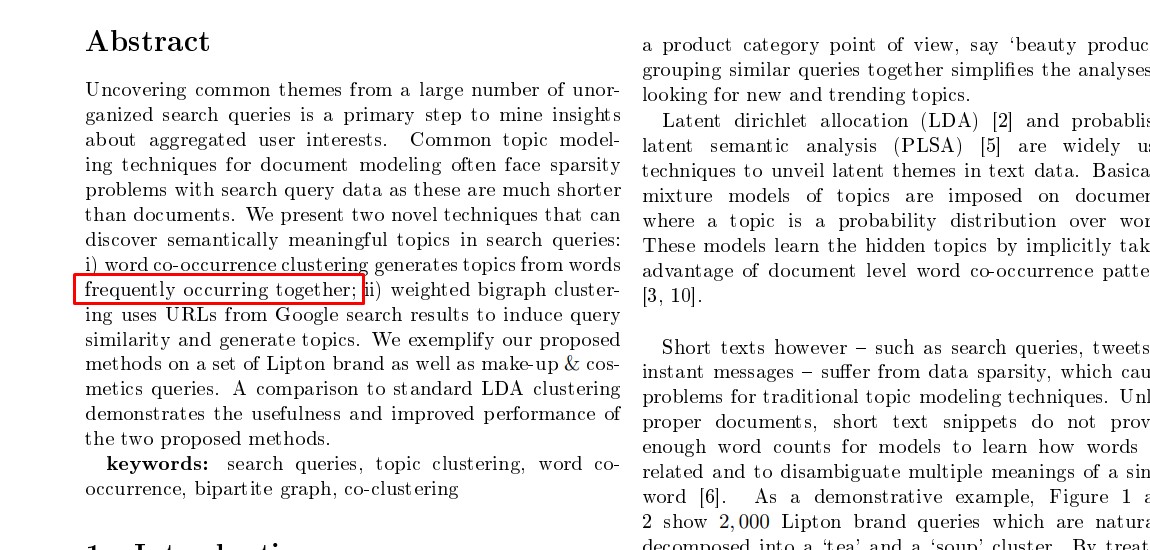
So, to stay accurate and follow what Google says, the LSI keywords are words that co-occur frequently with topic anchors in the given set of queries.
And Google is looking for word co-occurrence to generate topics and better understand your content.
So what does it mean a topic in SEO and keywords setting?
A topic is a Noun and any keyword or query that can be targeted with an individual article to target this noun/topic. However, for semantic reasons, this has to be related to your niche or targeted keyword so it makes sense for Google and users as well.
So LSI keywords model is similar to the topic cluster model I have shown you but for your one article only.
Let me give you an example.
Let’s say, you want to target the keyword “link building strategies” so you create your document and start creating an outline by adding the strategies you know.
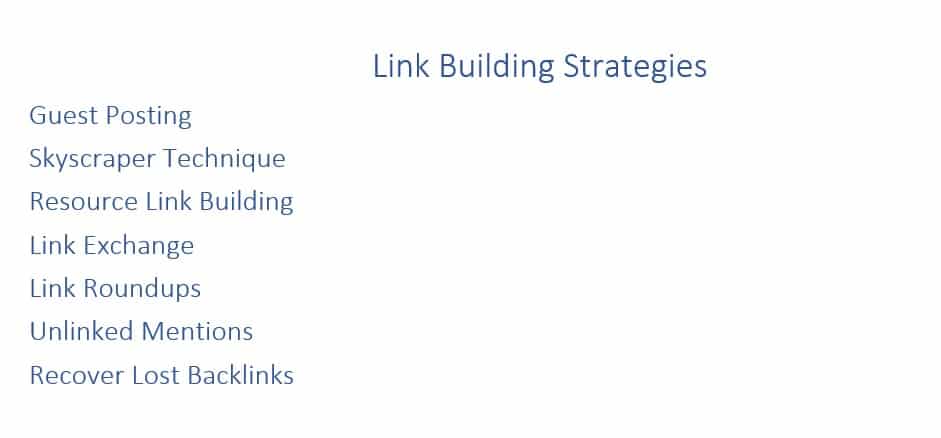
So, all these strategies are LSI keywords, as these frequently appear together with your targeted topic/keyword, “link building strategies”.
Then you add important category keywords and topics that are related to this topic which are, for example, Link Building, Off-Page SEO, and SEO as these are the main categories where this keyword/topic belongs to.
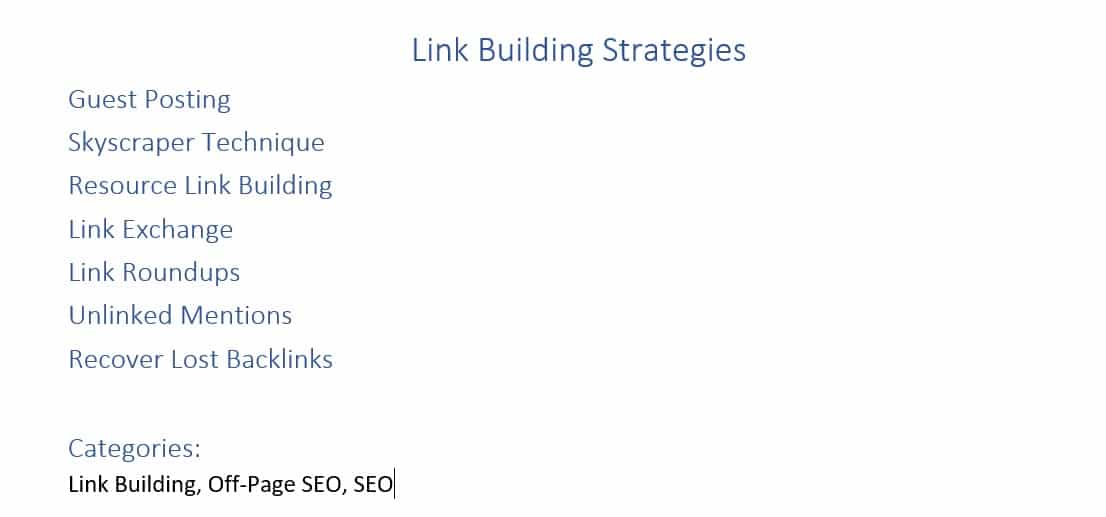
Then you can add other related LSI keywords or topics to this keyword such as “backlinks”, “pagerank”, “website authority”, “google ranking factors” etc.
You can also do keyword research to find related keywords to your targeted keyword like “link building tips”, “links for website”, and “how to build links for seo” as these are some of the great examples to include within your content.
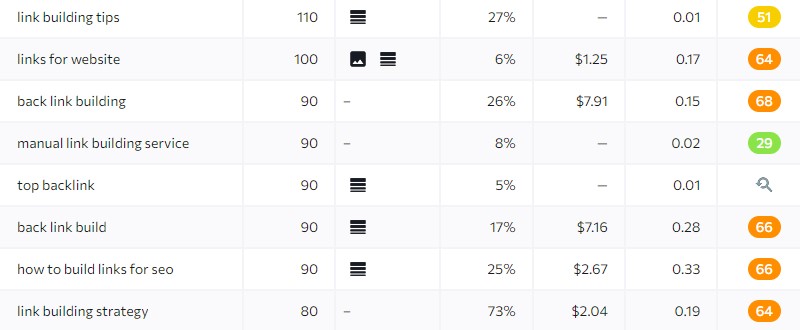
And after you have a solid outline and list of frequently appearing words together, which I call LSI keywords to help you rank higher in search and improve your ranking relevancy.
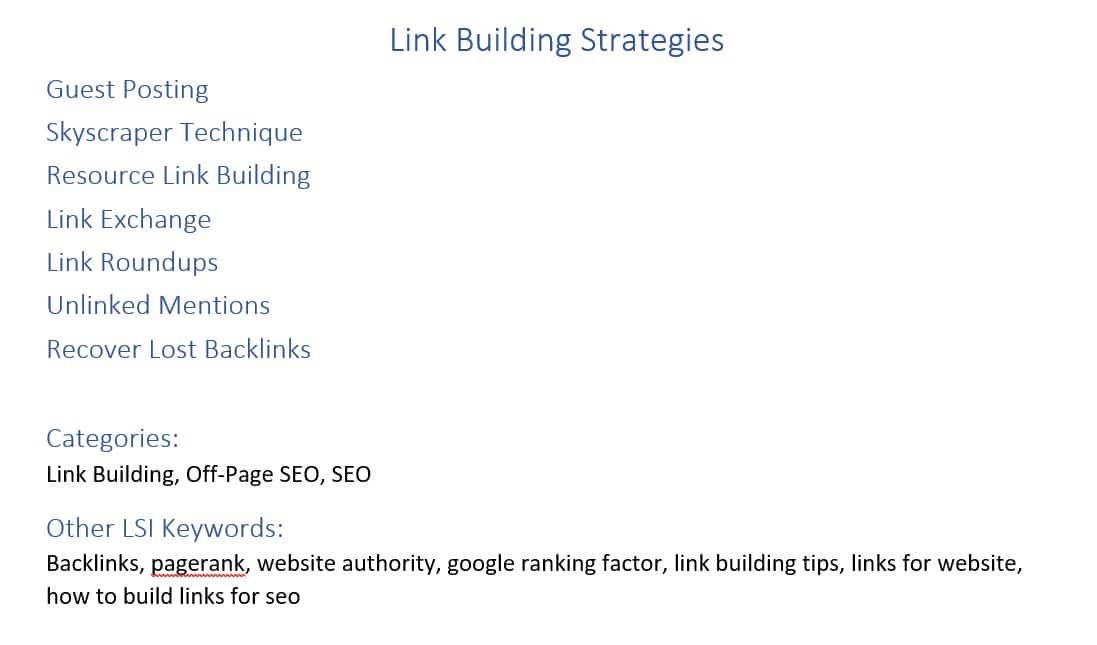
Of course, this is just an example and there could be a lot more LSI keywords. Also, in many cases, all these terms might appear in the next naturally without you even thinking about it. That’s why you need to be a subject matter expert.
But having a list of LSI keywords helps you to remember important terms that you should mention in your writing. However, it’s important to not sacrifice the quality of your content and write like a robot.
Practice #8: Optimize for Keyword Placements
The next important practice for your B2B blogging is to ensure you have optimized your SEO keyword placement.
Yes, Google, Bing, and other search engines are getting smarter with an understanding of your content on your website.
However, search engines are still using certain on-page SEO aspects to better understand what’s your content about when assessing your web page for ranking.
So let me show you the 8 best keyword placement practices by looking at one of my articles “White Hat SEO” and where I included the primary keyword as well as other LSI keywords:
- Include your primary keyword in the title tag and in the meta description include your primary and 1-2 LSI keywords in a natural fitting way.
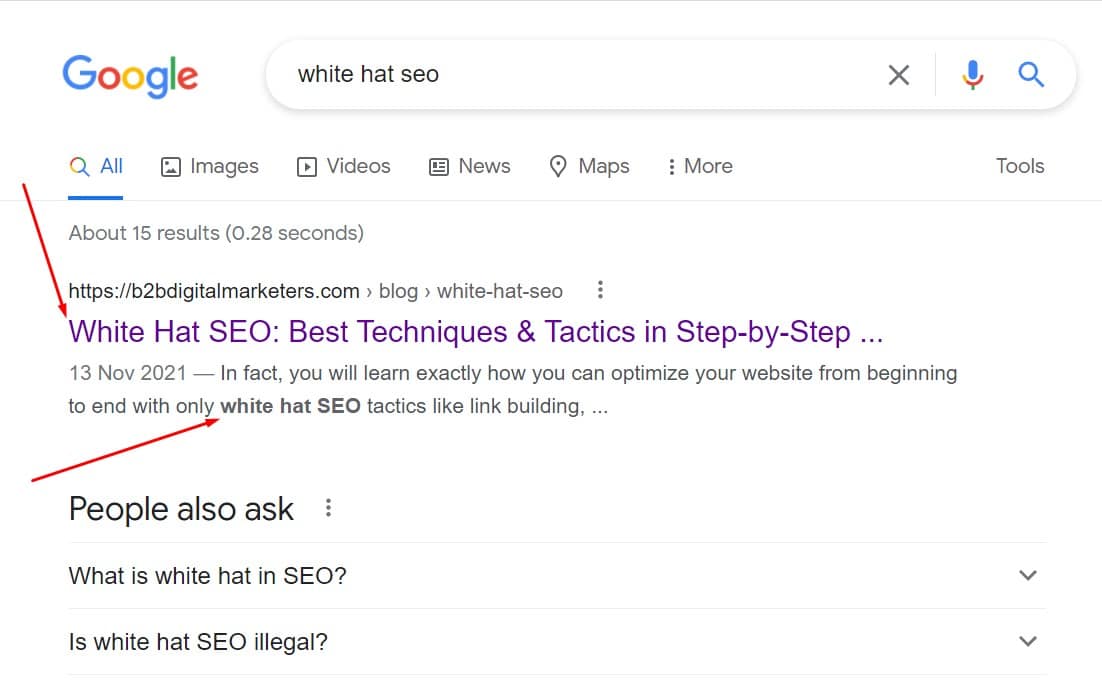
- Include only the primary keyword in your URL.
- Include your primary keyword in your Title with one important LSI keyword if possible. You can also include parts of the LSI keywords and words do not need to be in order.
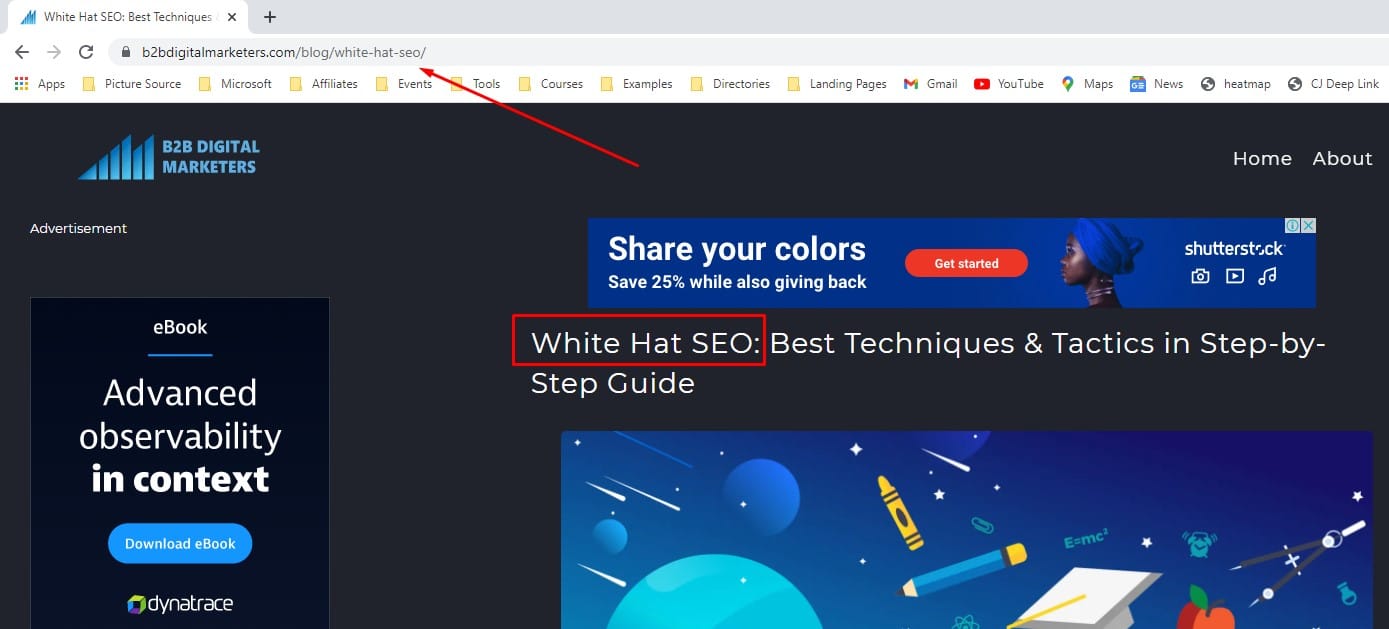
- Include your primary keyword as the name of the featured picture.
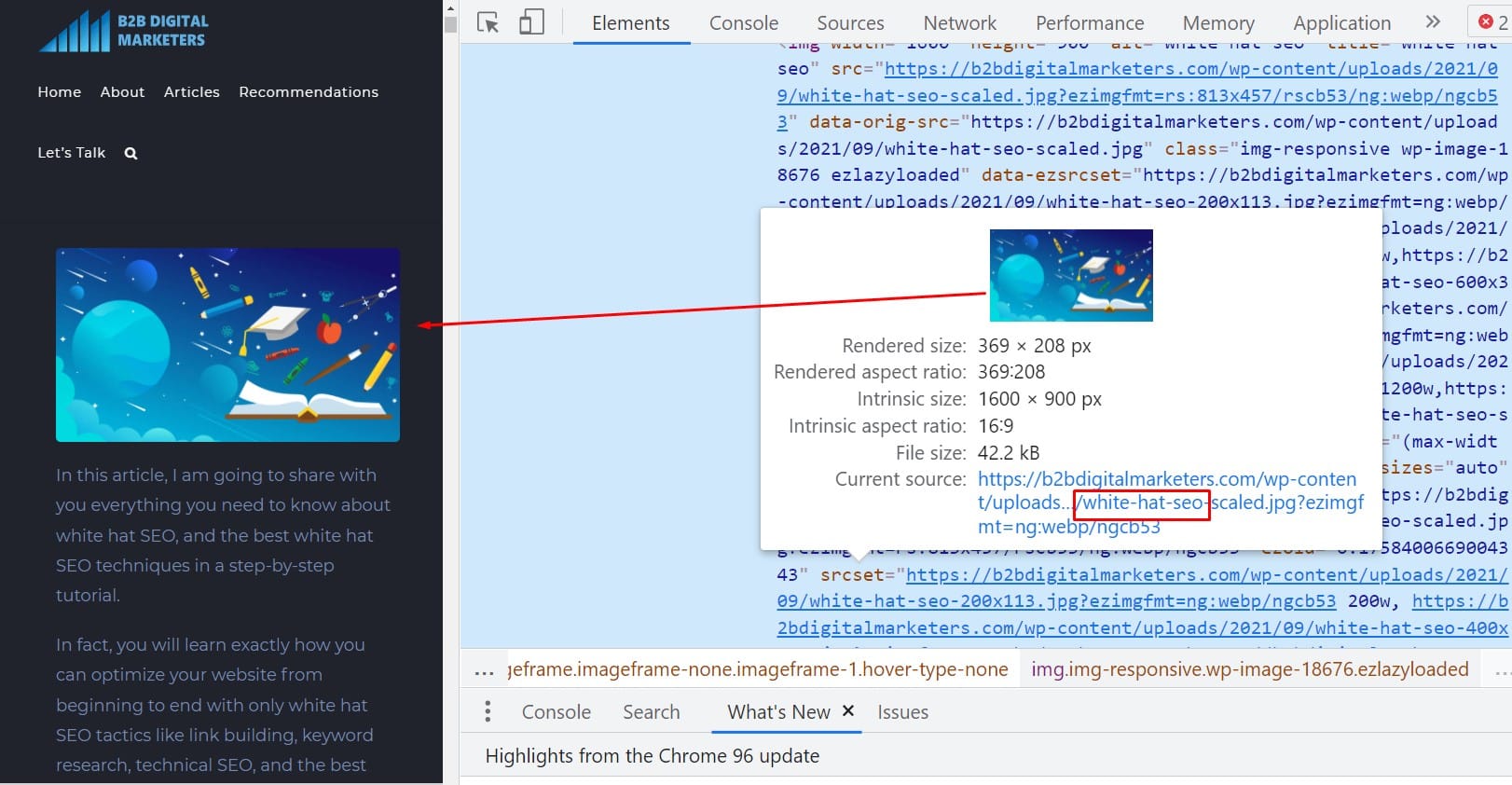
- Include your primary keyword in the introduction, the first 200 words with 1-2 LSI keywords.
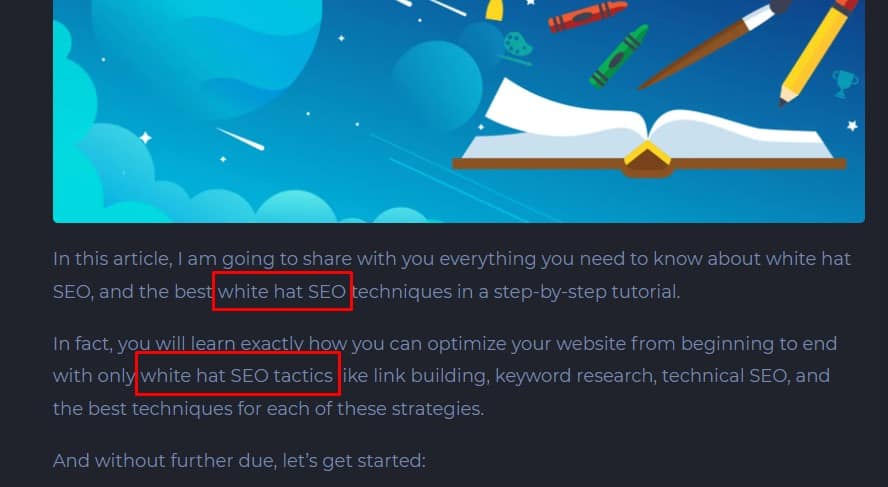
- Use primary and LSI keywords in other pictures names and alt-text in the article. But in the way that it makes like you would be explaining it to a blind person.
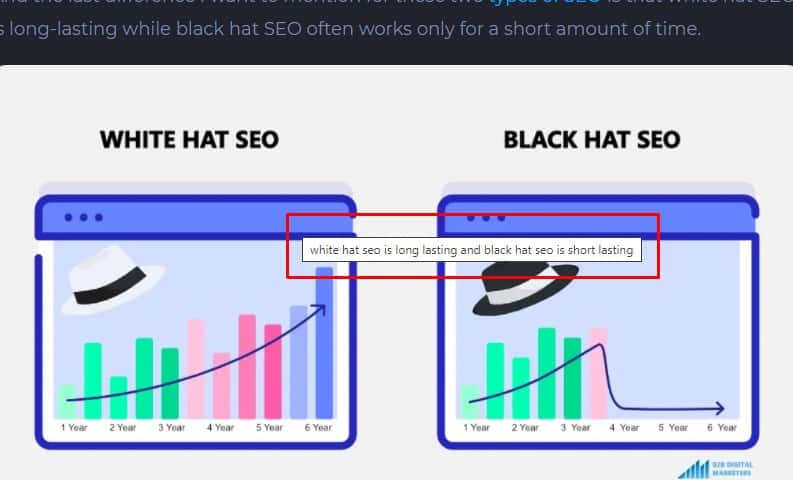
- Include your primary and LSI keywords In your content, but keep it in a natural way, don’t stress about keyword density. LSI keywords can be mentioned only once.
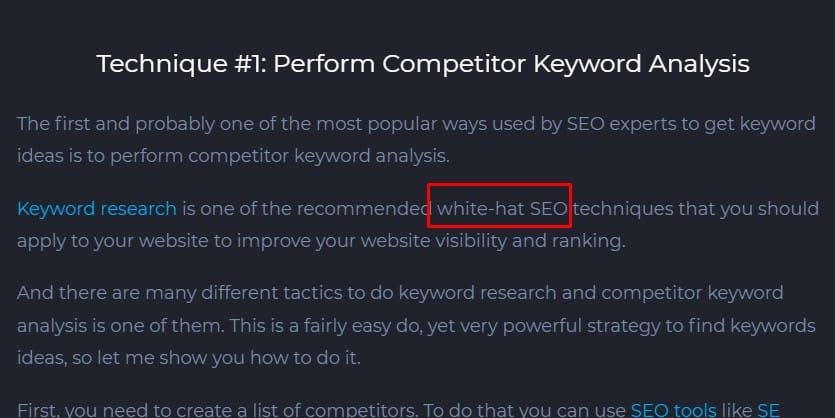
- Lastly, include your targeted keyword as the anchor text in other of your articles.
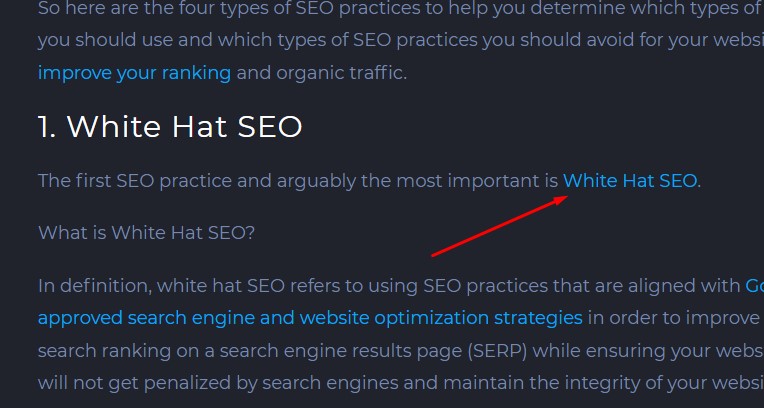
Keyword placement is still very much an important part of your on-page SEO and you should not neglect it!
However, you should also be very careful as keyword stuffing is against Google Quality Guidelines and can lead to getting penalized.
To learn more about keyword placement for WordPress check out my guide on how to add keywords and where to put keywords in WordPress.
Practice #9: Ensure Proper Internal Linking Strategy
The ninth important practice of your B2B blogging is to ensure you spend time on your internal linking strategy.
Internal links are very important for SEO and unfortunately, many marketers are skipping on these, which is a huge mistake.
Internal links are used by search engines in numerous ways like:
- Google is using internal links and the anchor text to get a better understanding of your content.
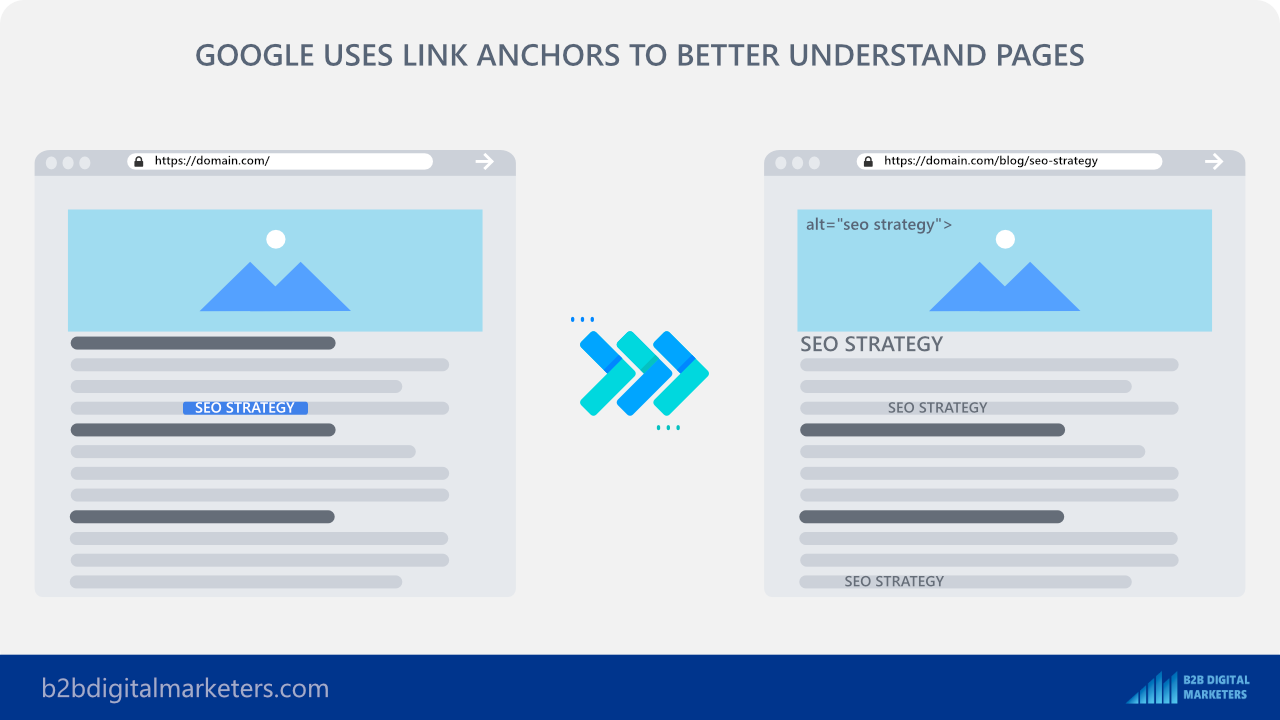
- Internal links are the #1 way how Google discover your website and the entire internet by crawling links on your pages.
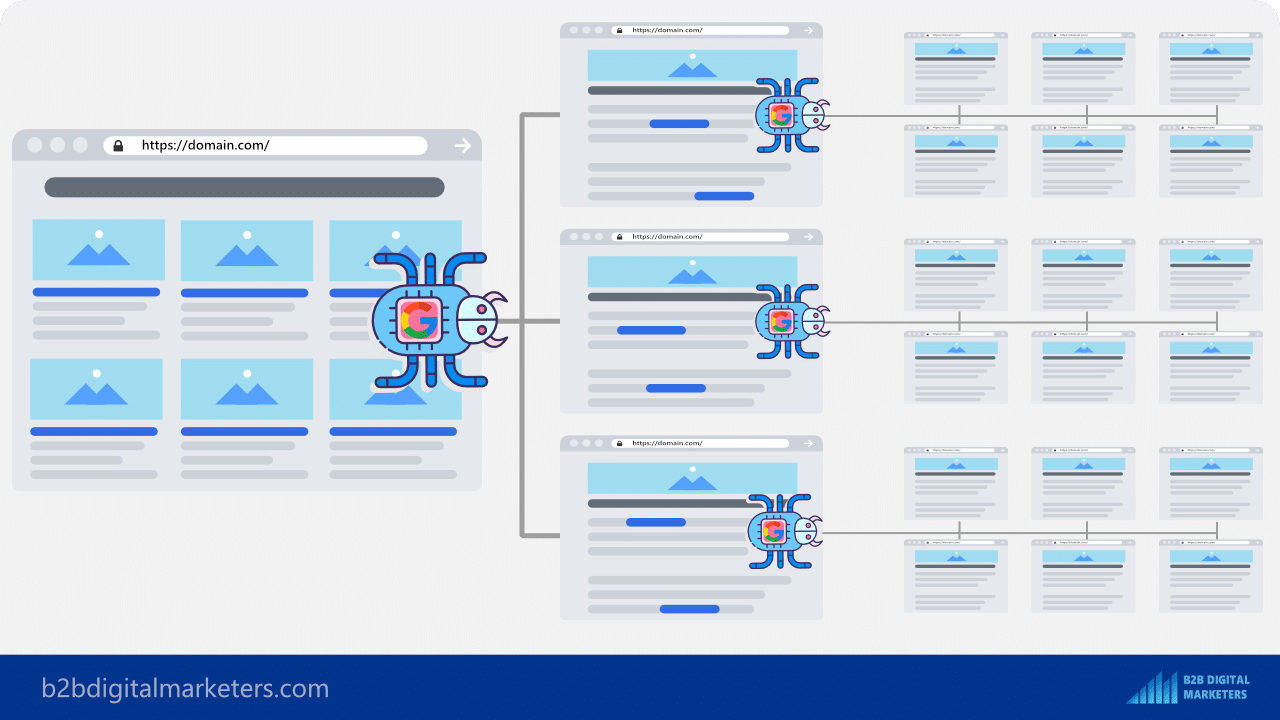
- Search engines are using internal links to understand the importance of the page. The more internal pages linking to a particular page, the more authority Google gives the page.
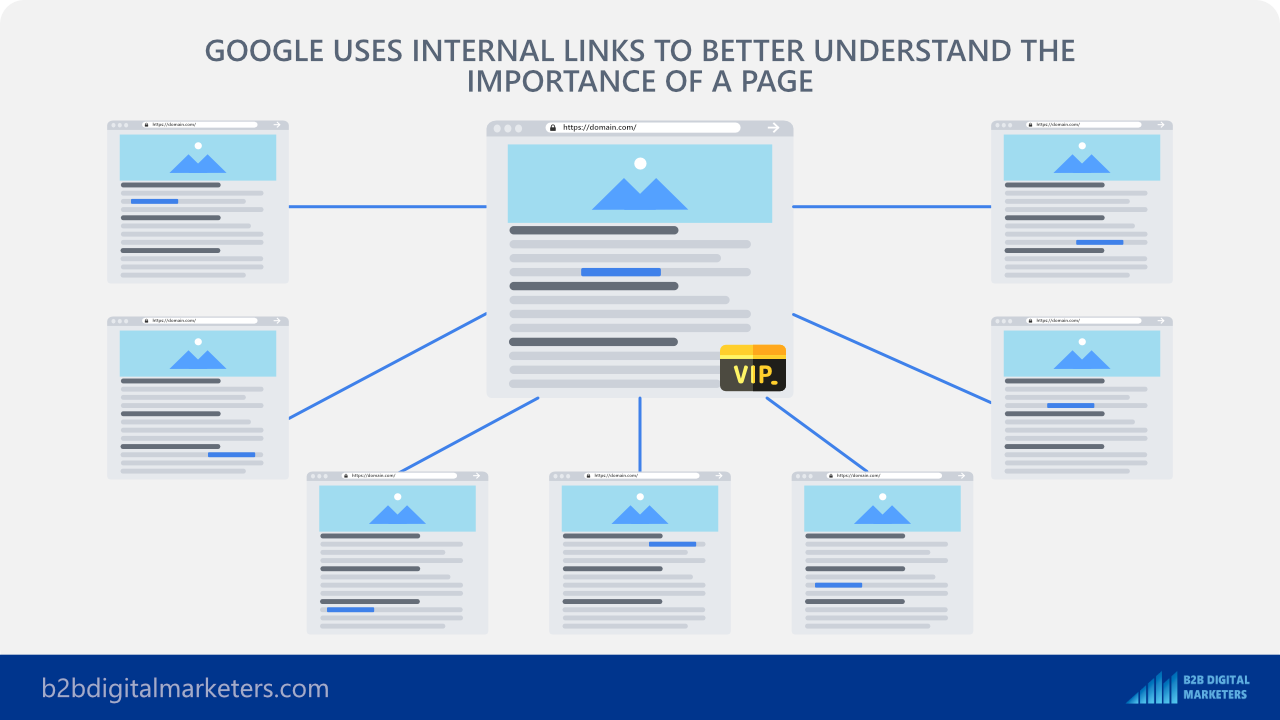
- With internal links, you can spread your PageRank to other important pages that do not get as many backlinks to improve your ranking. For example, your product pages can rank higher in search using internal linking.
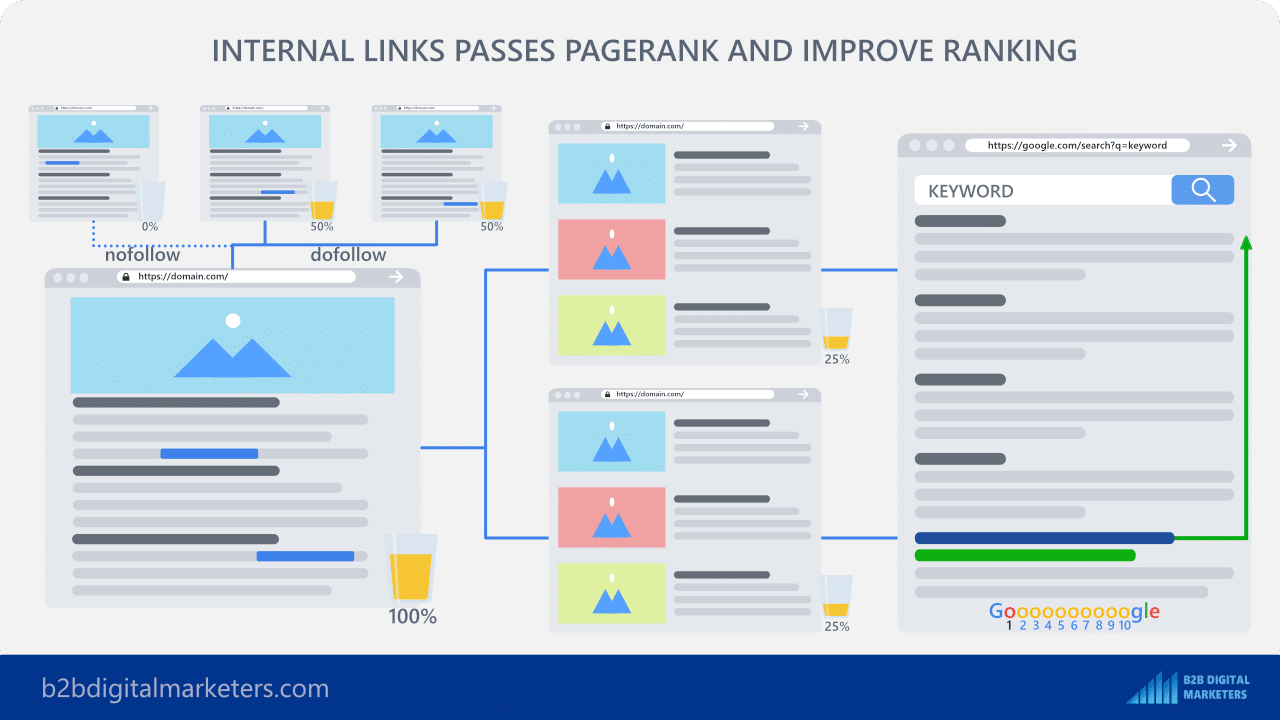
- Internal links help you to lower your click depth, and the lower click depth the more searching engine perceive the page as important.
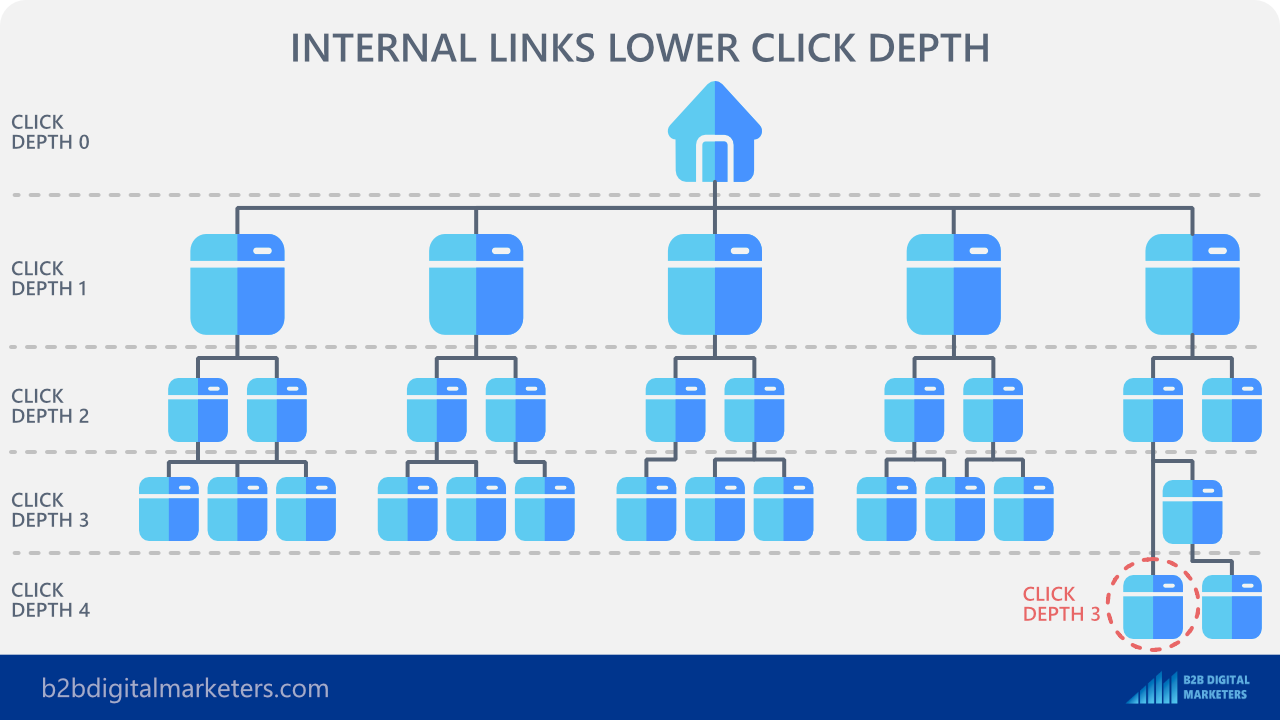
That’s why internal links are so important for SEO and you should always make sure your new pages get relevant internal links from your other pages.
Practice #10: Check Your On-Page SEO score
The tenth best practice for B2B blogging is to check your on-page SEO score.
Nowadays you have a lot of cool tools to check how well you have optimized your blog posts for on-page SEO.
But there are two tools I really want you to recommend and I always use them as a second and third pair of SEO eyes.
Tool #1: SEO Plugin to Check On-Page SEO Score
SEO plugin like Rank Math gives you an SEO checklist for on-page and content SEO for every of your web page to ensure you have applied the best SEO best practices for your new blog post.
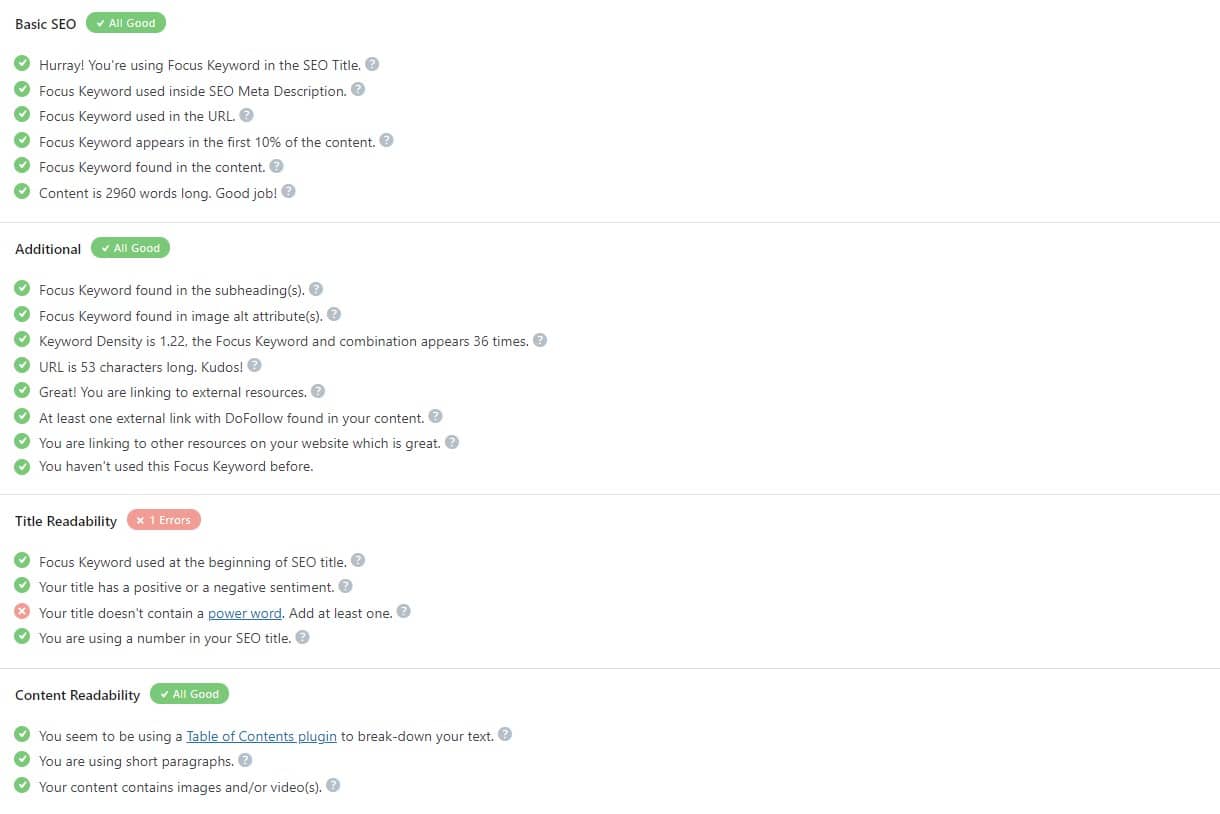
It also helps you to implement schema markup for your blog posts,
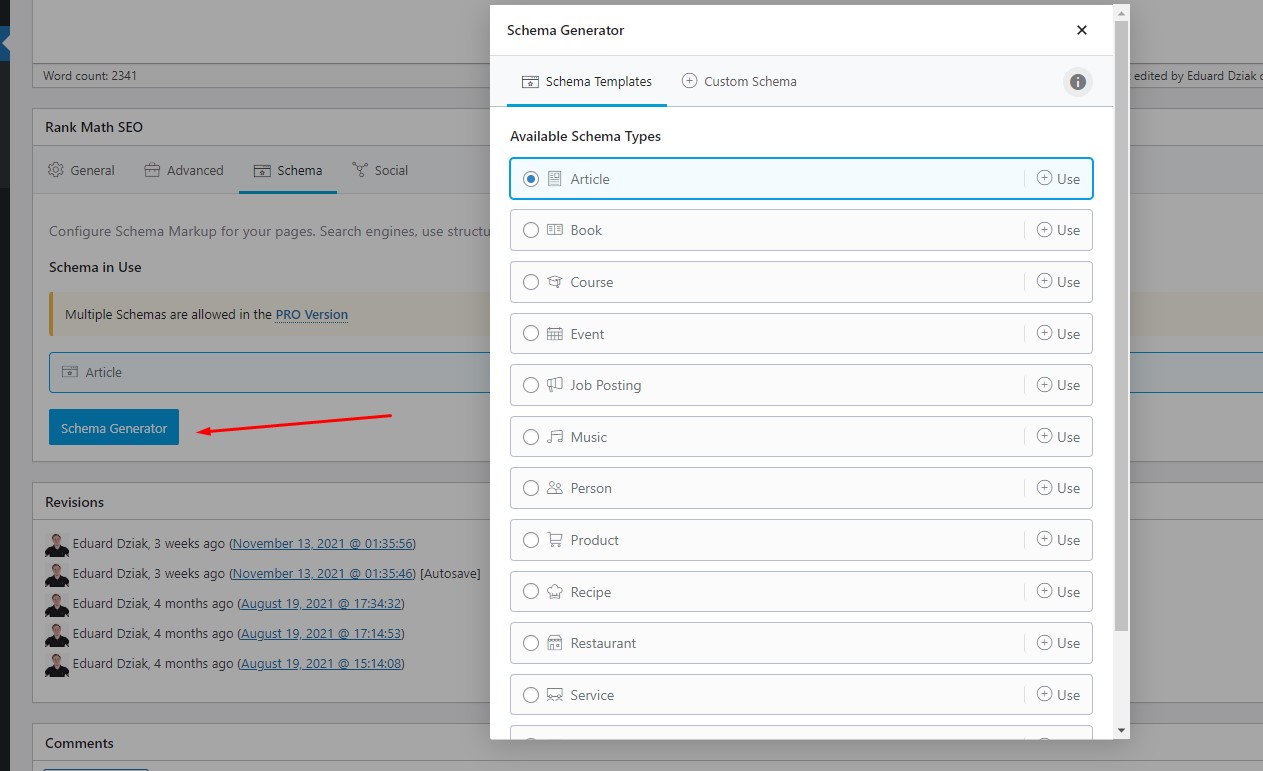
Create your title tag and meta description, and so much more.
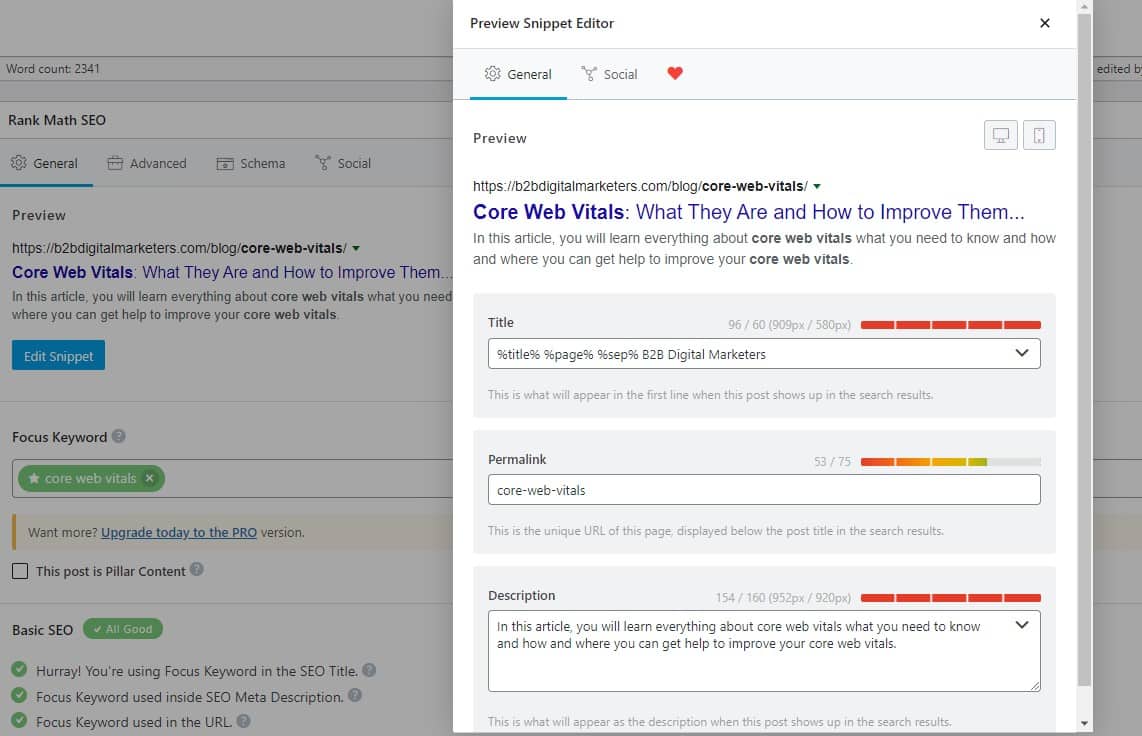
SEO plugins are a huge help for SEOs and regardless you are a seasoned SEO or a rookie, you should be using SEO plugins such as Rank Math.
Tool #2: On-Page SEO Checker
On-Page SEO checkers like from SE Ranking reveal errors that prevent your pages from ranking high in SERPs.
It gives you a comprehensive analysis of your blog post and checks how a certain page is optimized for certain search queries; whether the page complies with the ranking factors as well as analyzes the content for uniqueness and technical errors.
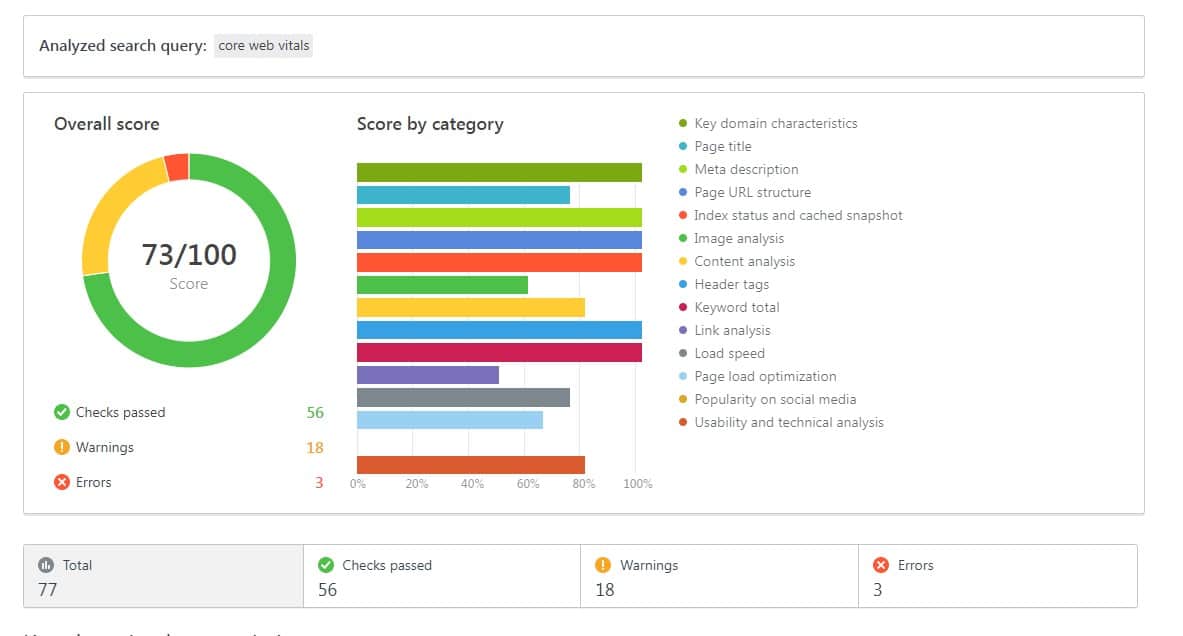
SE Ranking On-Page SEO checker analyzed parameters like:
(To get a 14-days free trial, sign up here)
- Domain characteristics
- Title and meta
- Page’s URL structure
- Index Analysis
- Image Analysis
- Keyword Analysis…
And if you compare the two scores from the SEO plugin and On-Page SEO checker, you can see, that according to the SEO plugin, my score is nearly perfect, but according to the on-page SEO checker, there is still a lot of things I can improve on.
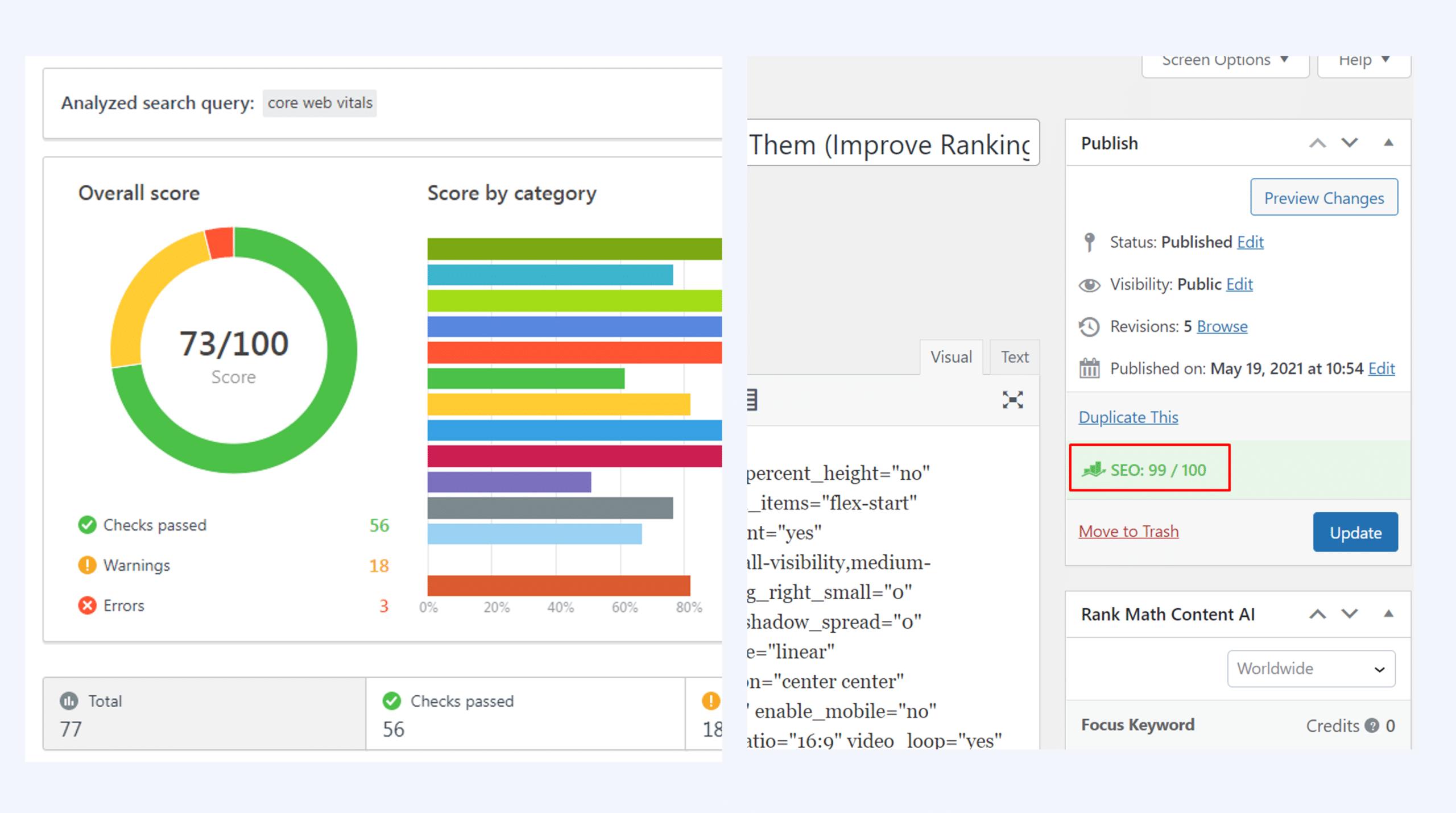
So, for me, both of these tools are essential to always publish fully optimized SEO articles.
Practice #11: Ensure You Keep Your Articles Updated
Another very important practice for your B2B blogging is to keep your article always updated.
This is one of the hardest parts of blogging as you will need to revisit your articles on regular basis and update them before you start losing ranking, organic traffic, and leads. This means:
- Adding more information
- Rewriting outdated information
- Changing pictures
- Improving word count
- Or even scrab everything and start from the start, when search intent changes.
Updating your old content is essential for your articles, especially for those that rank high in SERPs and drive organic traffic and/or leads for your business as if you don’t do that you can get replaced.
So, make sure you keep track of your keywords and articles and once you notice your ranking, CTR, or organic traffic is dropping, it might be a sign that is time to perform historical optimization for your blog post.
For sure, check out my video on how you can do that, or read my article.
Practice #12: Be Guest Posting Part of Your B2B Blogging Strategy
The next important part of your B2B blogging and your B2B Blog strategy is to grow your backlink portfolio using guest posting.
Guest posting is almost as old as me and we both still function very well…
No seriously, despite guest posting is being one of the oldest link building strategies it is still very effective if you do it right.
And link building expert Matt Diggity stated in his video on “SEO predictions” that backlinks might become even more important and 50% of backlinks come from guest posting strategy.
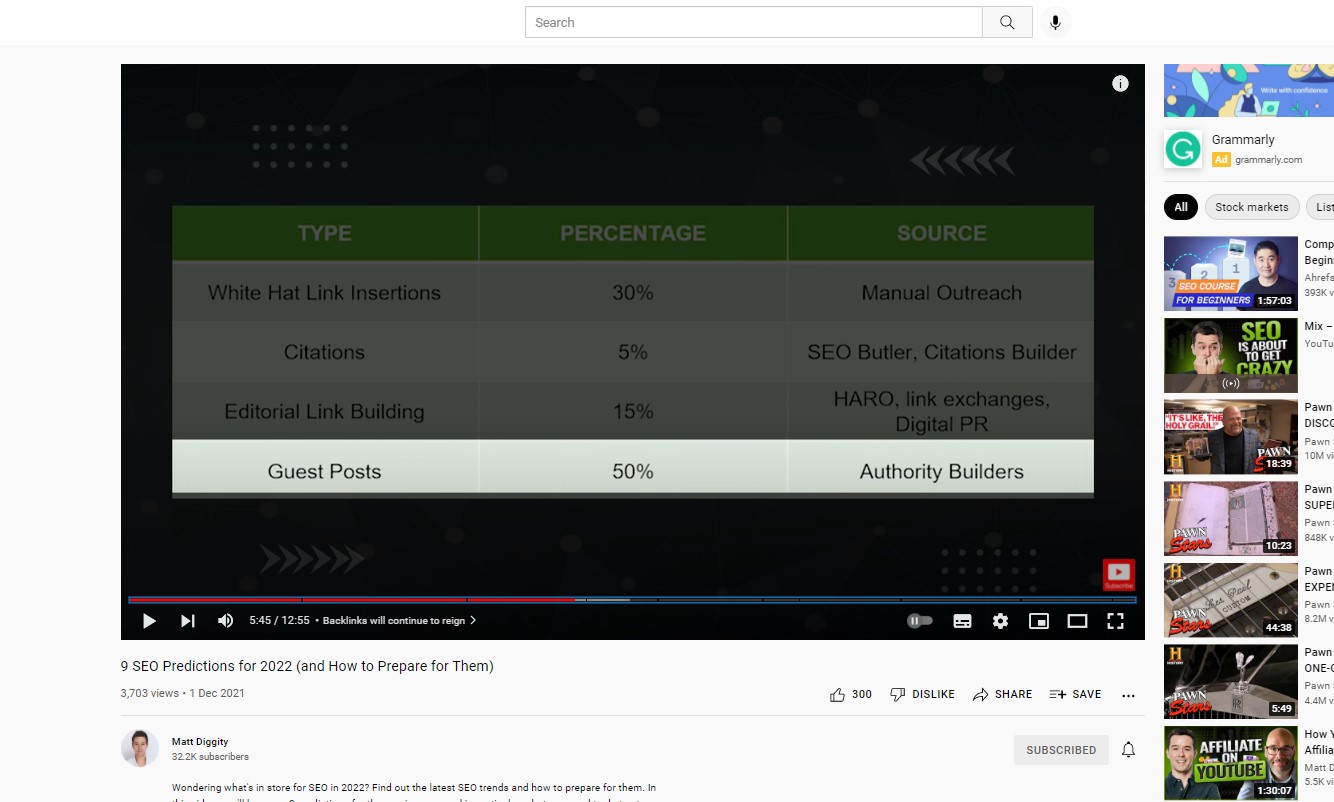
However, you must do it right, because Google does not fancy guest posting for link building and they devalue the backlinks as guest posting results in unnatural links.
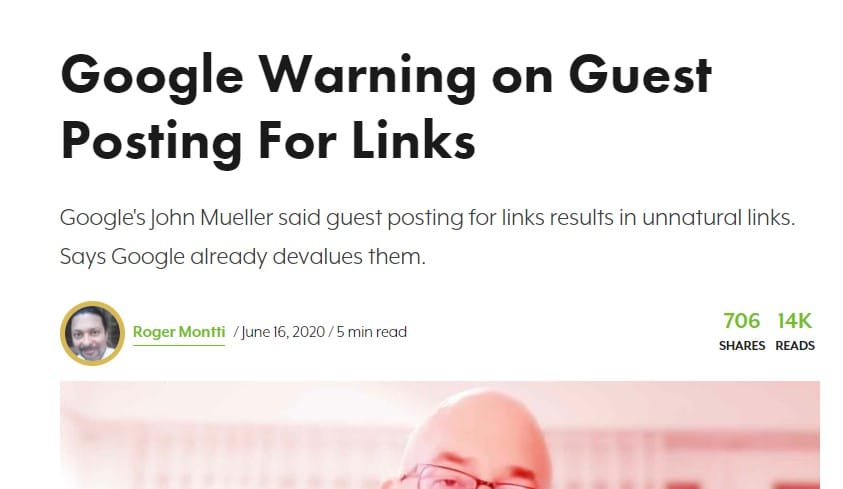
With that being said, if you want to learn how to properly start with guest posting you can watch my video right here:
Or read my article, so you can avoid the biggest link building mistake that can cost you a lot of your time, resources and not get the results you expected.
Practice #13: Create Social Fortress for SEO
Another best practice for B2B blogging I have for you is to create your social fortress for SEO as part of your off-page SEO effort.
The social fortress is a process of building your online presence by registering your business and claiming your domain on social media to get backlinks and then adding links on your website to your social media to connect them together in order to start building trust with Google and your users.
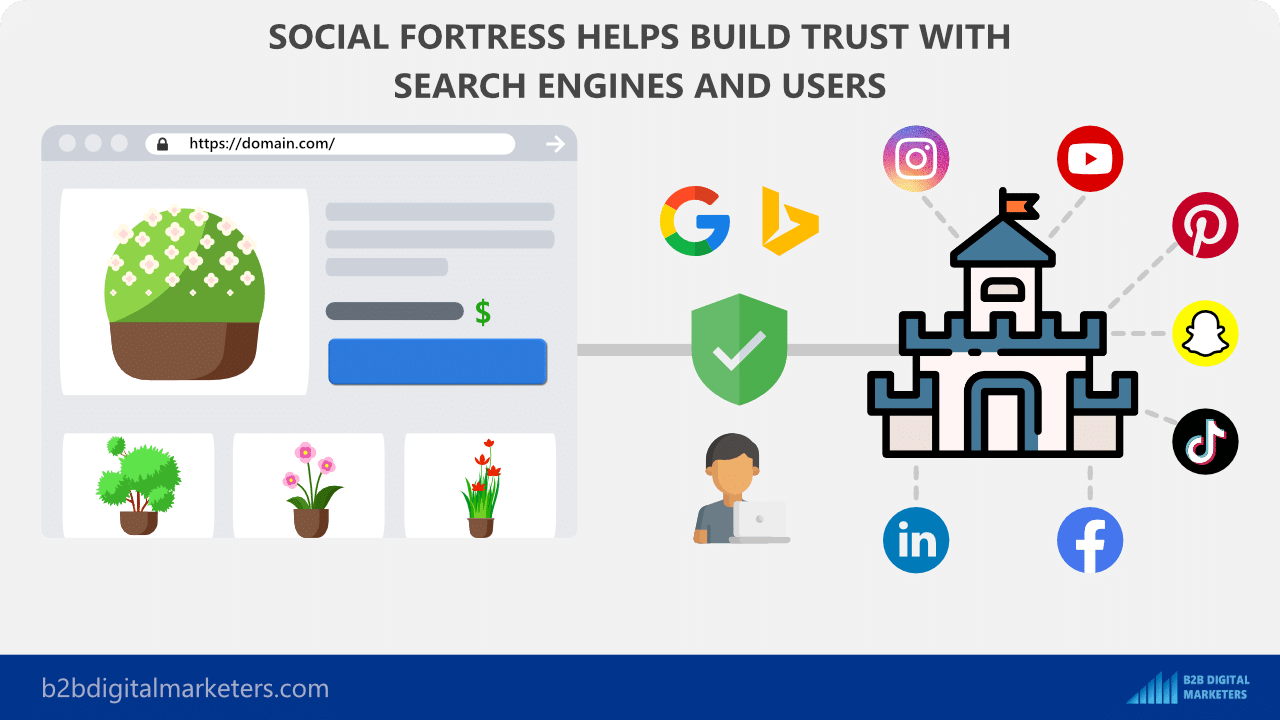
The reason why social fortress is important is that when you create a new website, Google puts you into a Sandbox according to Matt Diggity.
This is because Google has very little information about your new website to decide if you are a good boy or not.
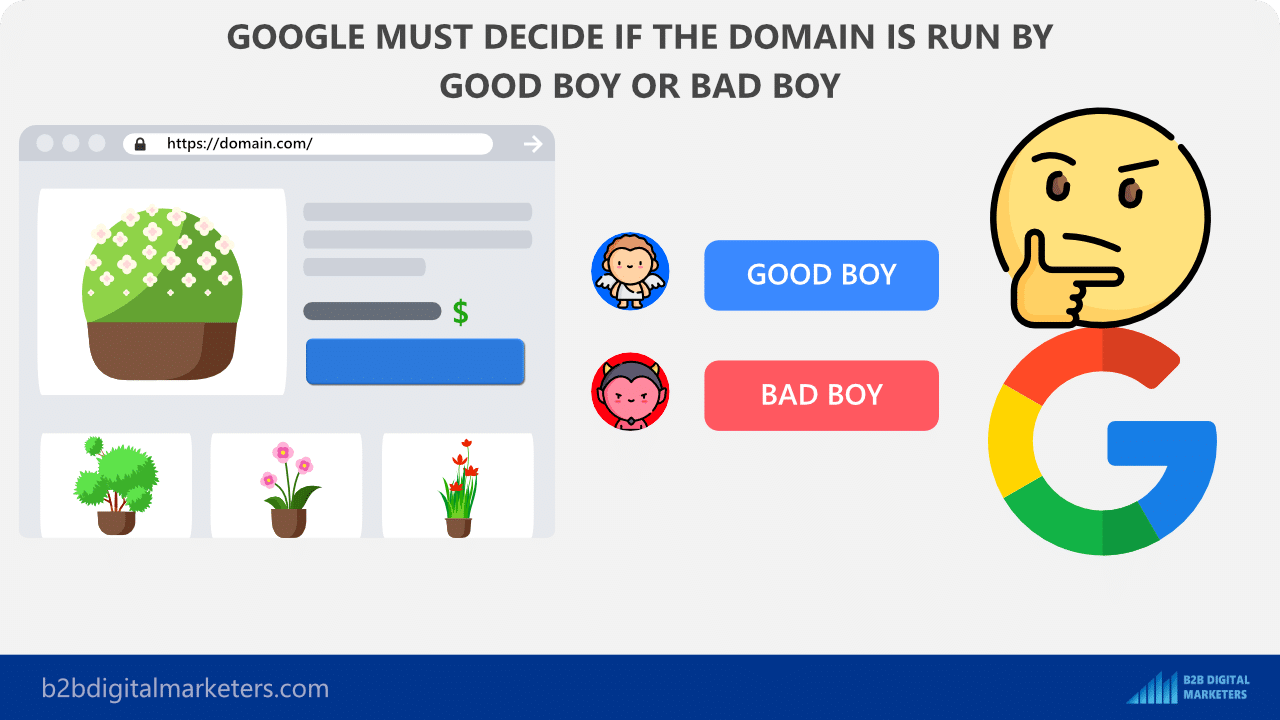
And by creating a social fortress you will start mimicking the way how common business starts their online journey – they create websites, register on social media, start sharing their content there to attract a few users to their website.
So, this works as a trust signal for Google about your website and blogging and it is very important to not skip this step. Plus, Google gets an extra source of information about your business, which at the beginning has very little.
For example, as you can see, I have created my YouTube channel, where I have linked to my website,
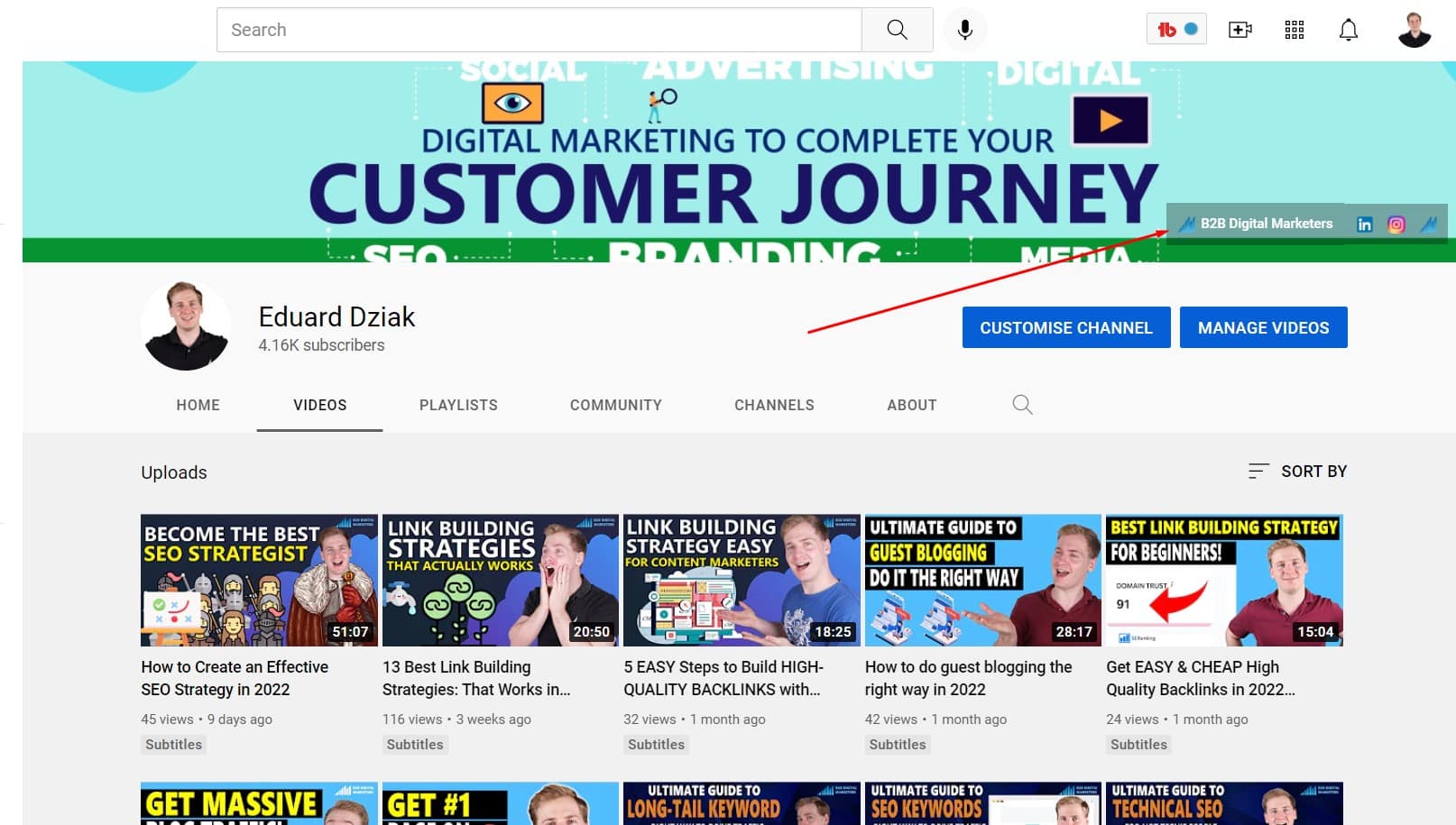
And my LinkedIn company page. And both got me backlink from these authority websites.
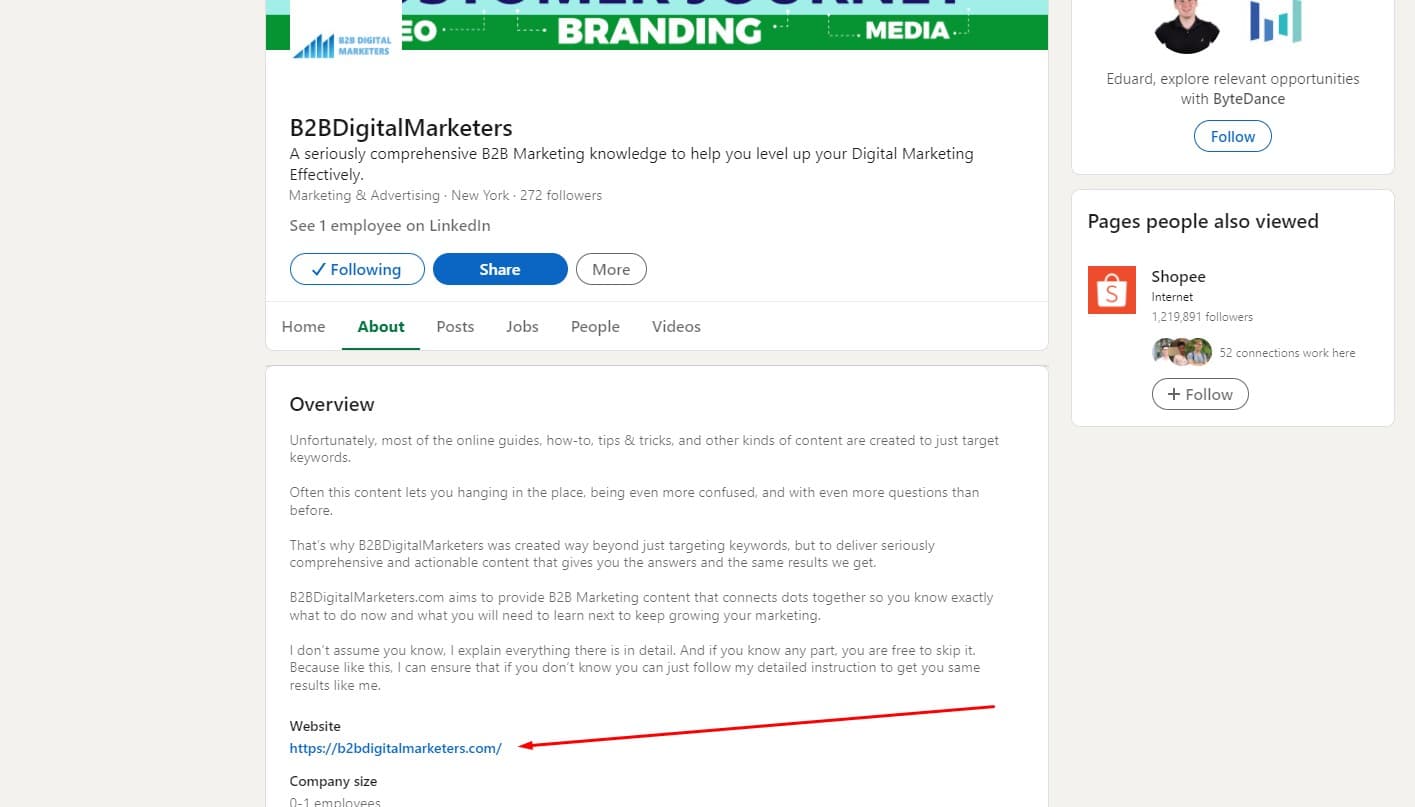
And on both of these platforms, I am sharing my content to increase traffic to my blog posts and generate social signals.
And of course, I could register on other social media like Facebook and Twitter to improve my social fortress for SEO even more.
Practice #14: Analyze Competitors Backlinks
And the very last best practice for B2B blogging I have for you is to analyze your competitor’s backlinks.
Competitor backlink analysis is one of the best ways to start your link building campaign as it gives you important information about how your competitors are building backlinks, what is working in the industry, finding high-quality backlink opportunities and so much more.
For example, you can use SE Ranking Competitors tool to get a list of your close competitors based on your ranking keywords.
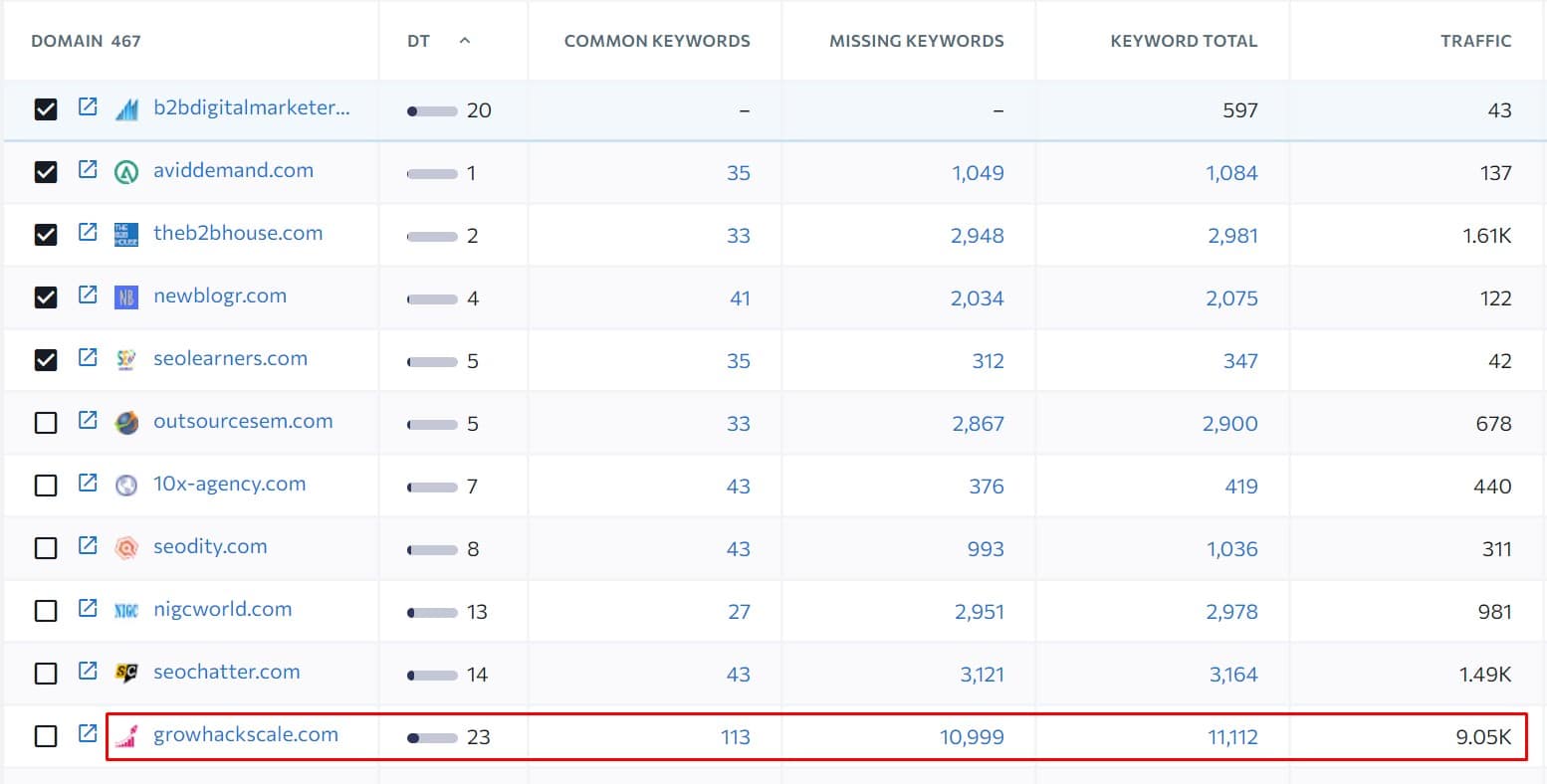
Then select one of your close competitors, for example with similar domain trust, and pop their domain into SE Ranking Backlink Checker.
Here you will get plenty of useful information about the competitor backlink profile such as the number of backlinks, referring domains, the dofollow and nofollow ratio, how many EDU backlinks and GOV backlinks are linking to the website, and more.
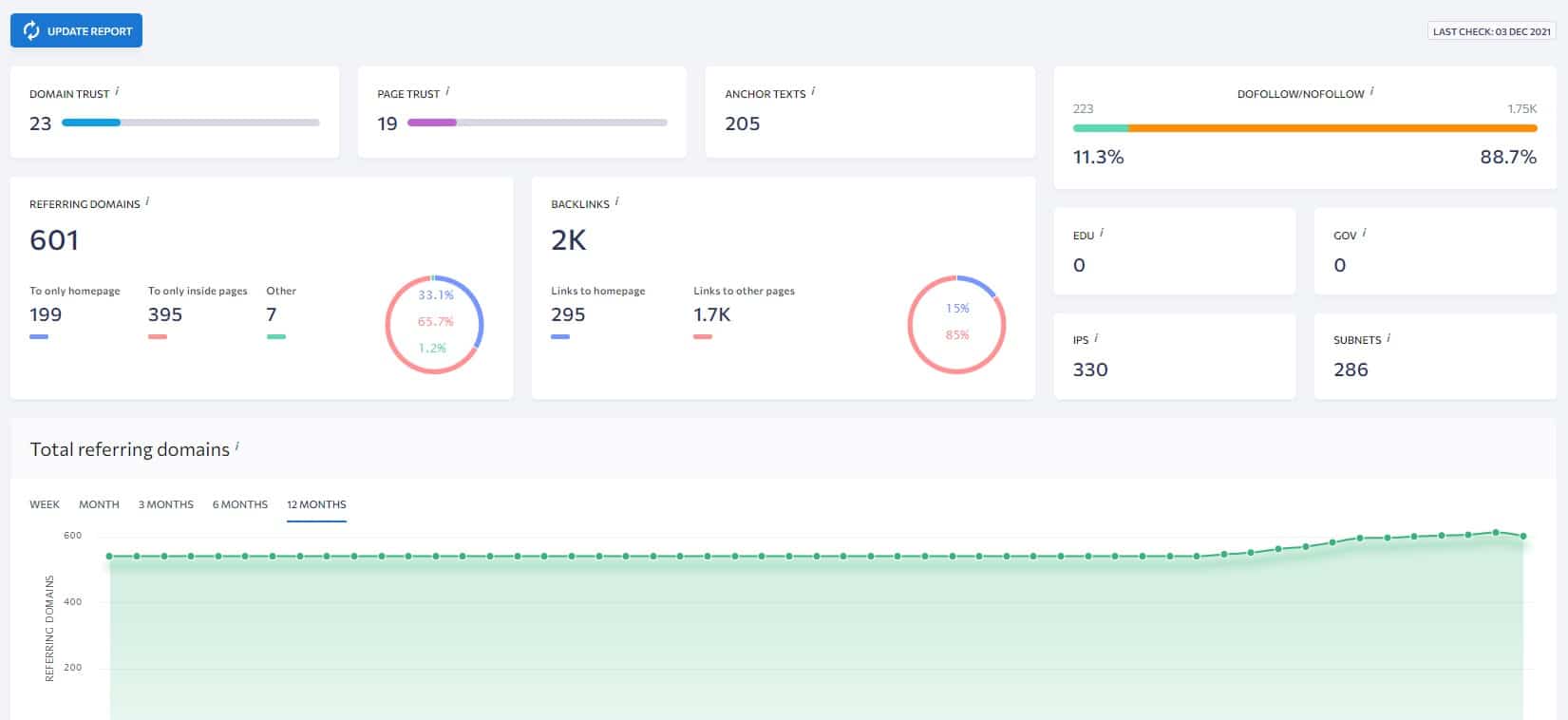
Then you can go to the pages report to see what pages generate most of their backlinks.
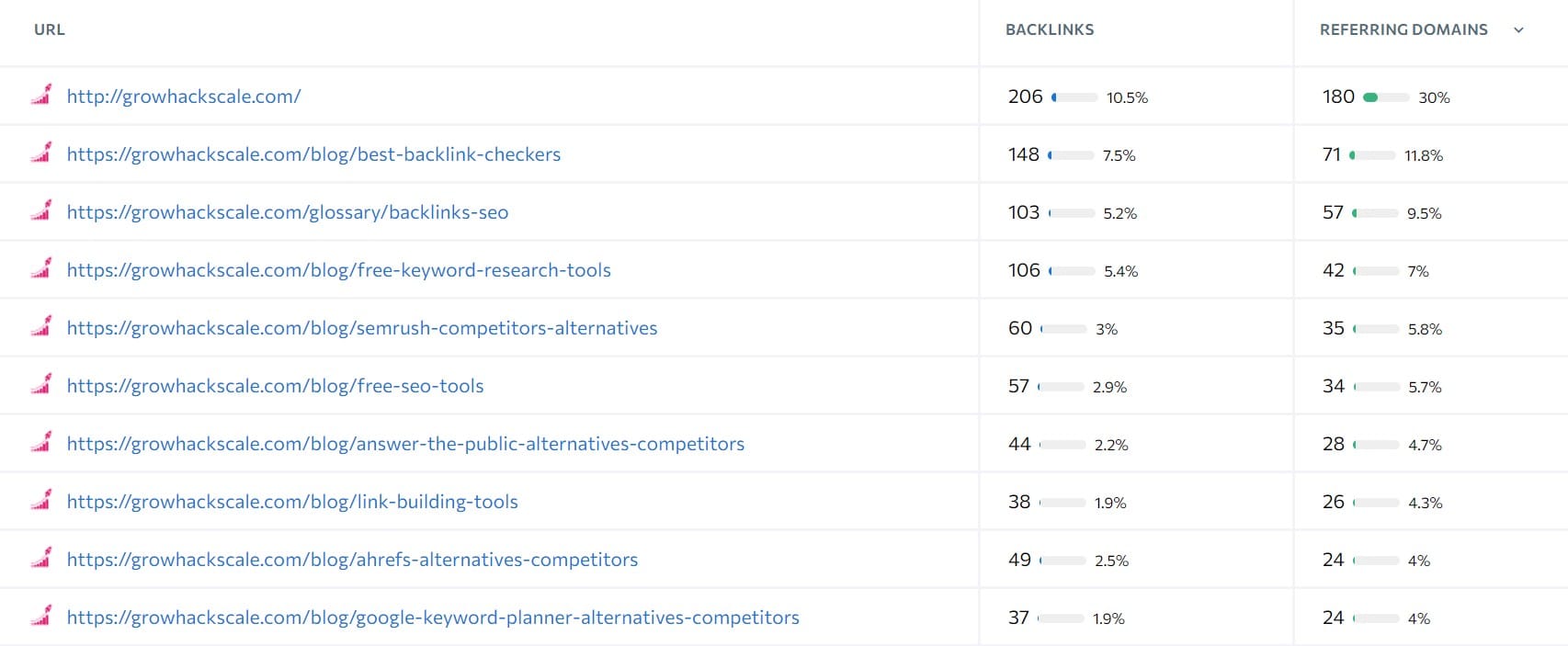
As you can see, this guy is going hard on affiliate keywords.
Anyway, competitor backlink analysis is a great way to find great ideas for B2B blogging, understand what pages drive the most backlinks or what pages are the most important for your competitors.
Back to You
So here you have some of the best practices for B2B blogging to help you generate more organic traffic, leads, and/or sales for your business.
Remember, that blogging is about quality and the articles should be written by experts who understand your industry.
It’s easy to get cheap writers but those won’t do the trick, especially in B2B blogging and more technical niches.
Also, let me know on my YouTube channel which practice was the most useful to you and what are some of your best practices for B2B blogging.
Related Articles:
- How to Use B2B SEO and B2B Content Marketing for Lead Generation [6 Easy Steps in 2021]
- 7 Ultimate Benefits of B2B Blog for Your Business
- 5 Critical B2B Content Marketing Tactics That Actually Works
- SEO Competitor Analysis: How to Beat SEO Competitors [+Template]
- Technical SEO: Step-By-Step Guide to Optimize Your Website
- 11 Best Ways How to Make Money with SEO
- How to Sell Leads to Companies and Brokers
- Best 11 Top AI Writing Tools for Content and SEO Writing 2023 (Free & Paid)
Also, check out our SEO hub page to find all our Content Marketing resources.
Disclaimer
This article was created by Eduard Dziak and may contain affiliate links. The following were used to optimize the article for the best user and search engine experience include:
- SE Ranking for keyword research and on-page SEO optimization
- Surfer SEO for SEO-friendly content creation for users and search engines.
- Jasper AI for grammar correction and information enhancement.
The article is based on the author’s own experience and knowledge, drawn from both their own work and that of their clients, to provide the latest, proven methods.








